Operational Cost Analysis in Food & Beverage
VerifiedAdded on 2020/02/18
|22
|4445
|120
AI Summary
This assignment delves into the analysis of operational costs within South Korea's food and beverage industry. It examines various contributing factors, such as input product prices, labor costs, and material wastage. The assignment also explores potential solutions for cost reduction by analyzing survey data collected from industry professionals. These insights aim to provide a comprehensive understanding of the challenges faced by the sector and suggest practical strategies for mitigating operational expenses.
Contribute Materials
Your contribution can guide someone’s learning journey. Share your
documents today.
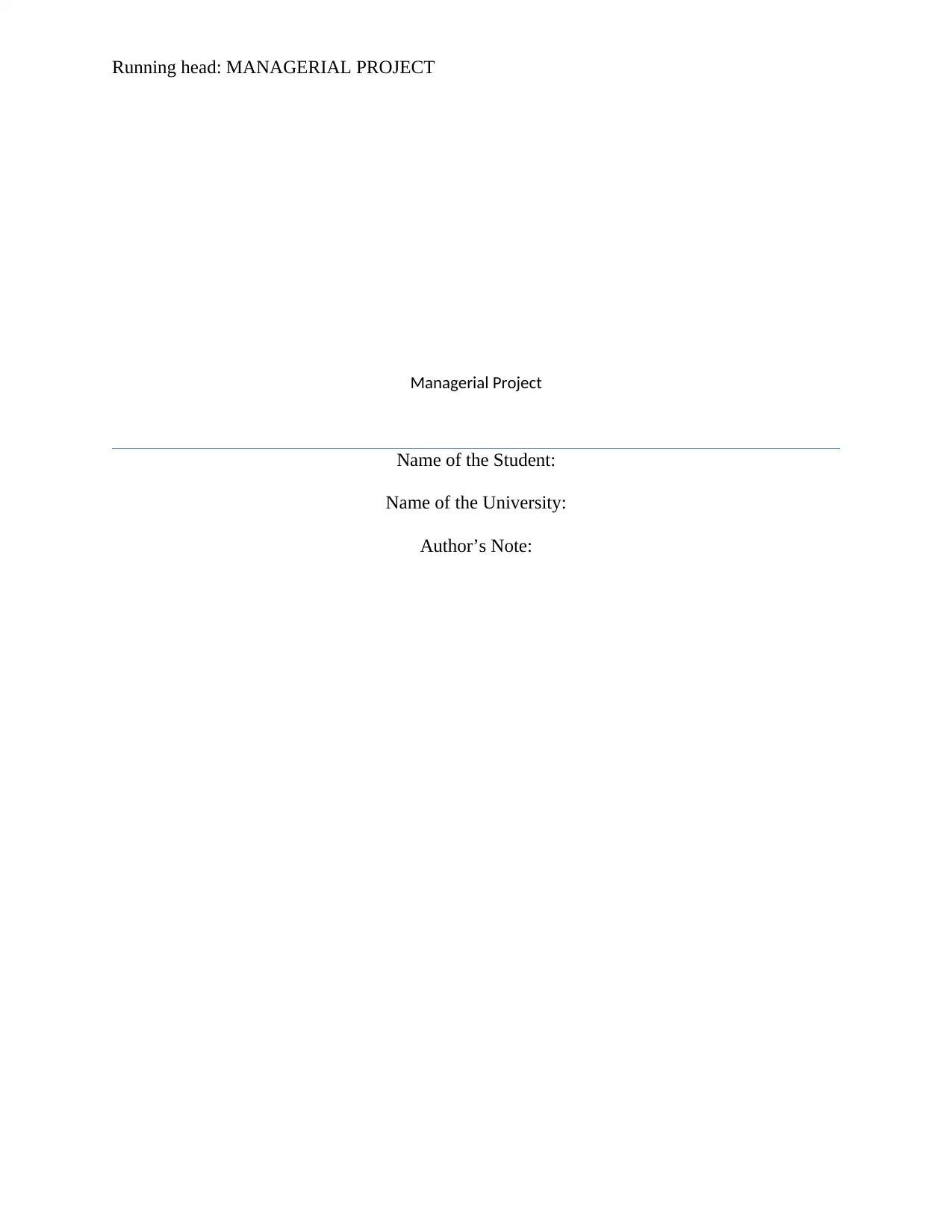
Running head: MANAGERIAL PROJECT
Managerial Project
Name of the Student:
Name of the University:
Author’s Note:
Managerial Project
Name of the Student:
Name of the University:
Author’s Note:
Secure Best Marks with AI Grader
Need help grading? Try our AI Grader for instant feedback on your assignments.
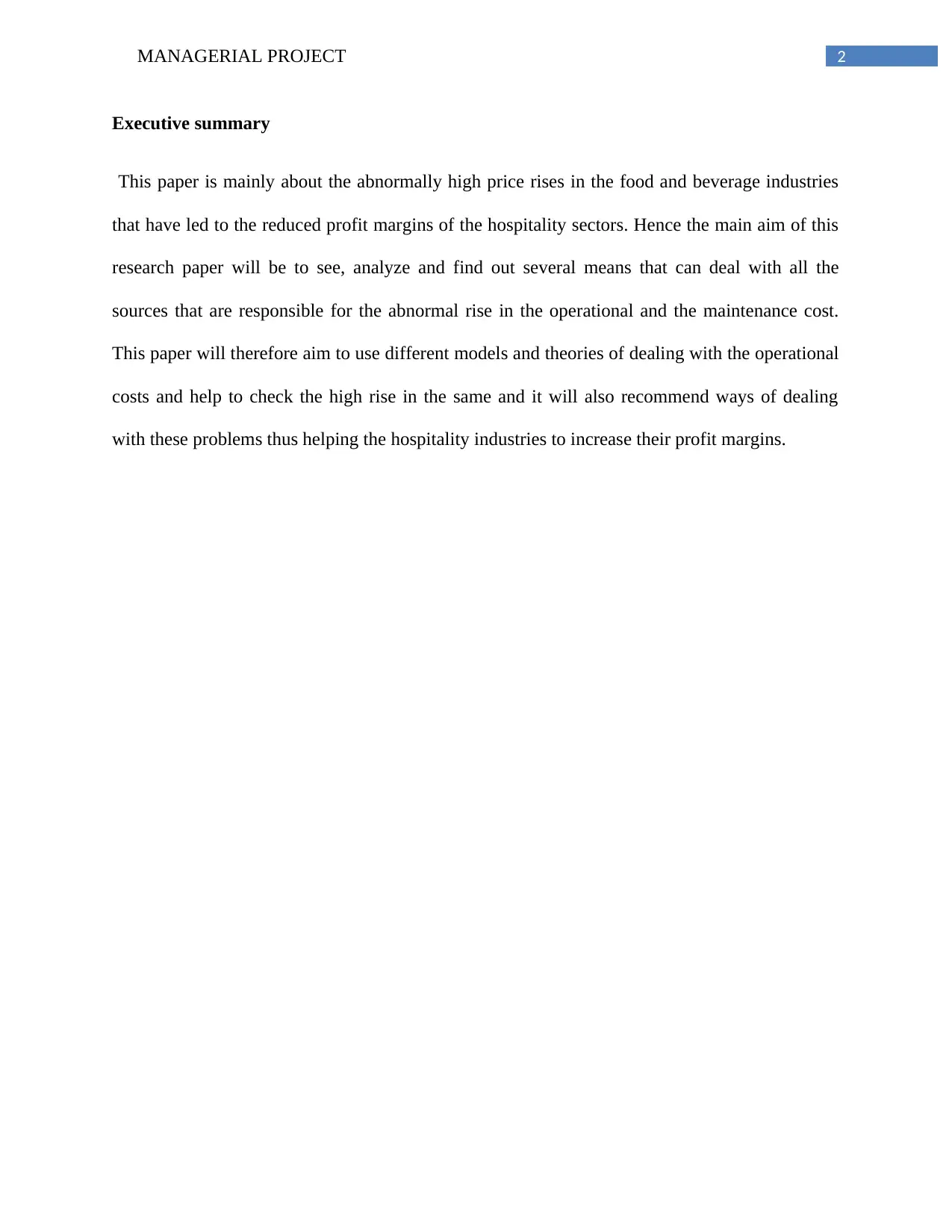
2MANAGERIAL PROJECT
Executive summary
This paper is mainly about the abnormally high price rises in the food and beverage industries
that have led to the reduced profit margins of the hospitality sectors. Hence the main aim of this
research paper will be to see, analyze and find out several means that can deal with all the
sources that are responsible for the abnormal rise in the operational and the maintenance cost.
This paper will therefore aim to use different models and theories of dealing with the operational
costs and help to check the high rise in the same and it will also recommend ways of dealing
with these problems thus helping the hospitality industries to increase their profit margins.
Executive summary
This paper is mainly about the abnormally high price rises in the food and beverage industries
that have led to the reduced profit margins of the hospitality sectors. Hence the main aim of this
research paper will be to see, analyze and find out several means that can deal with all the
sources that are responsible for the abnormal rise in the operational and the maintenance cost.
This paper will therefore aim to use different models and theories of dealing with the operational
costs and help to check the high rise in the same and it will also recommend ways of dealing
with these problems thus helping the hospitality industries to increase their profit margins.
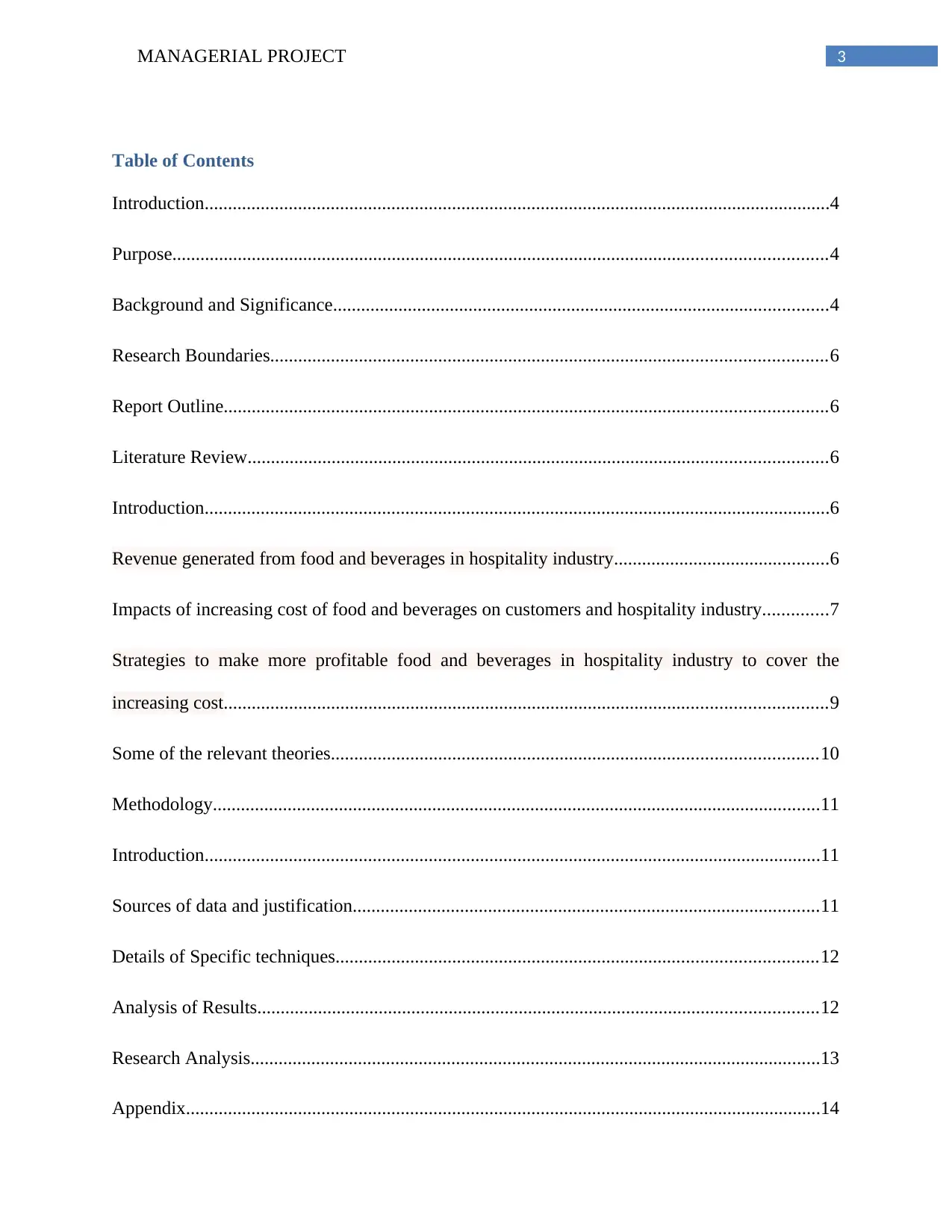
3MANAGERIAL PROJECT
Table of Contents
Introduction......................................................................................................................................4
Purpose............................................................................................................................................4
Background and Significance..........................................................................................................4
Research Boundaries.......................................................................................................................6
Report Outline.................................................................................................................................6
Literature Review............................................................................................................................6
Introduction......................................................................................................................................6
Revenue generated from food and beverages in hospitality industry..............................................6
Impacts of increasing cost of food and beverages on customers and hospitality industry..............7
Strategies to make more profitable food and beverages in hospitality industry to cover the
increasing cost.................................................................................................................................9
Some of the relevant theories........................................................................................................10
Methodology..................................................................................................................................11
Introduction....................................................................................................................................11
Sources of data and justification....................................................................................................11
Details of Specific techniques.......................................................................................................12
Analysis of Results........................................................................................................................12
Research Analysis..........................................................................................................................13
Appendix........................................................................................................................................14
Table of Contents
Introduction......................................................................................................................................4
Purpose............................................................................................................................................4
Background and Significance..........................................................................................................4
Research Boundaries.......................................................................................................................6
Report Outline.................................................................................................................................6
Literature Review............................................................................................................................6
Introduction......................................................................................................................................6
Revenue generated from food and beverages in hospitality industry..............................................6
Impacts of increasing cost of food and beverages on customers and hospitality industry..............7
Strategies to make more profitable food and beverages in hospitality industry to cover the
increasing cost.................................................................................................................................9
Some of the relevant theories........................................................................................................10
Methodology..................................................................................................................................11
Introduction....................................................................................................................................11
Sources of data and justification....................................................................................................11
Details of Specific techniques.......................................................................................................12
Analysis of Results........................................................................................................................12
Research Analysis..........................................................................................................................13
Appendix........................................................................................................................................14
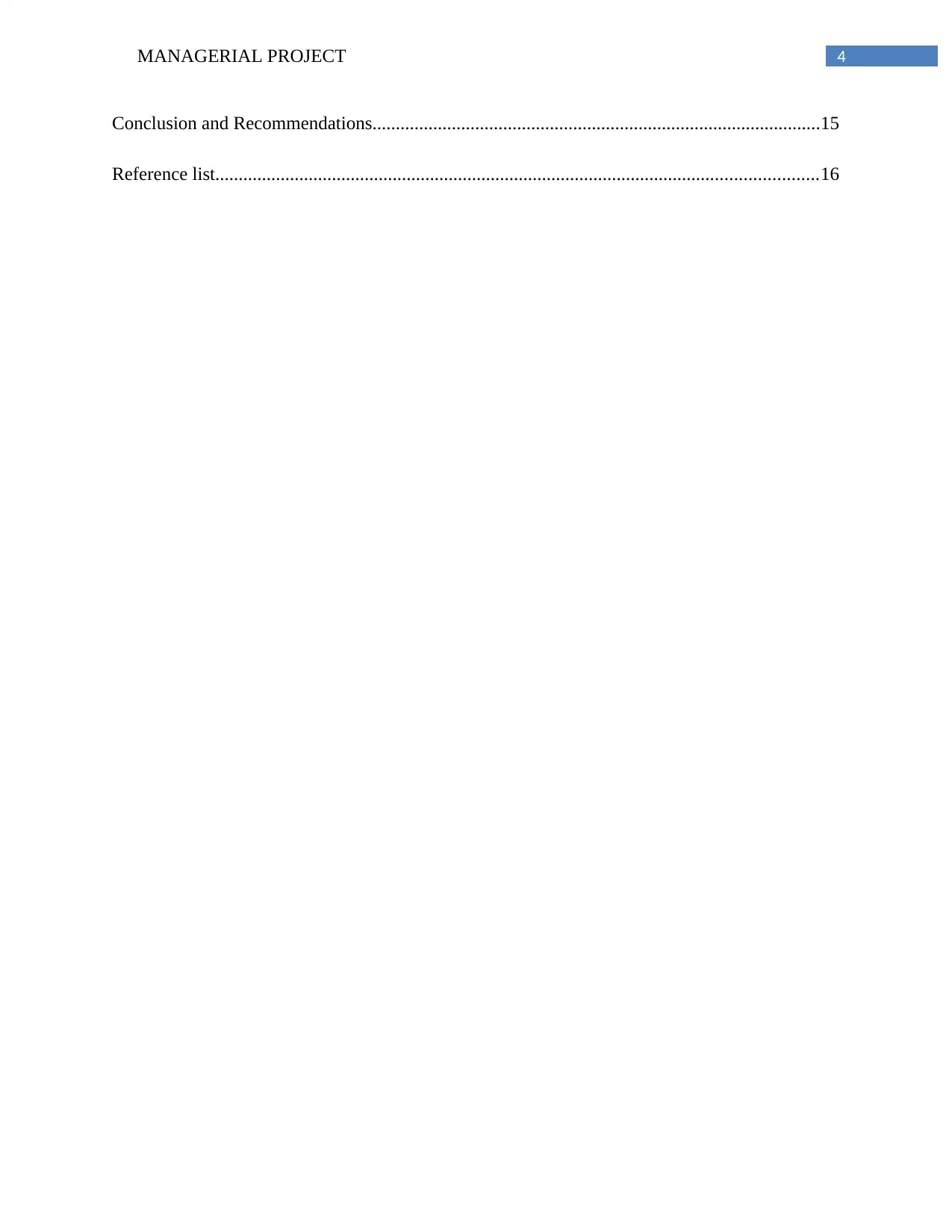
4MANAGERIAL PROJECT
Conclusion and Recommendations................................................................................................15
Reference list.................................................................................................................................16
Conclusion and Recommendations................................................................................................15
Reference list.................................................................................................................................16
Paraphrase This Document
Need a fresh take? Get an instant paraphrase of this document with our AI Paraphraser
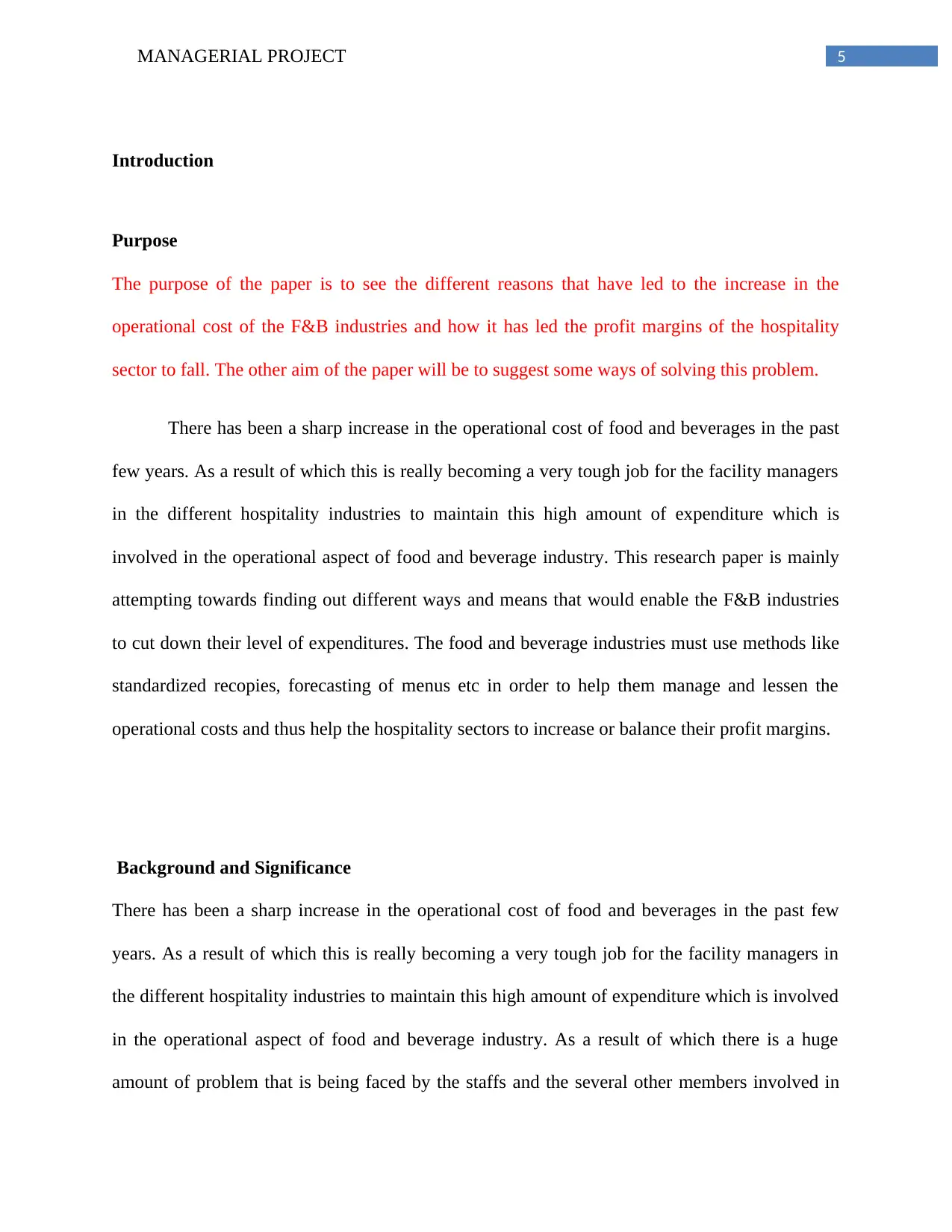
5MANAGERIAL PROJECT
Introduction
Purpose
The purpose of the paper is to see the different reasons that have led to the increase in the
operational cost of the F&B industries and how it has led the profit margins of the hospitality
sector to fall. The other aim of the paper will be to suggest some ways of solving this problem.
There has been a sharp increase in the operational cost of food and beverages in the past
few years. As a result of which this is really becoming a very tough job for the facility managers
in the different hospitality industries to maintain this high amount of expenditure which is
involved in the operational aspect of food and beverage industry. This research paper is mainly
attempting towards finding out different ways and means that would enable the F&B industries
to cut down their level of expenditures. The food and beverage industries must use methods like
standardized recopies, forecasting of menus etc in order to help them manage and lessen the
operational costs and thus help the hospitality sectors to increase or balance their profit margins.
Background and Significance
There has been a sharp increase in the operational cost of food and beverages in the past few
years. As a result of which this is really becoming a very tough job for the facility managers in
the different hospitality industries to maintain this high amount of expenditure which is involved
in the operational aspect of food and beverage industry. As a result of which there is a huge
amount of problem that is being faced by the staffs and the several other members involved in
Introduction
Purpose
The purpose of the paper is to see the different reasons that have led to the increase in the
operational cost of the F&B industries and how it has led the profit margins of the hospitality
sector to fall. The other aim of the paper will be to suggest some ways of solving this problem.
There has been a sharp increase in the operational cost of food and beverages in the past
few years. As a result of which this is really becoming a very tough job for the facility managers
in the different hospitality industries to maintain this high amount of expenditure which is
involved in the operational aspect of food and beverage industry. This research paper is mainly
attempting towards finding out different ways and means that would enable the F&B industries
to cut down their level of expenditures. The food and beverage industries must use methods like
standardized recopies, forecasting of menus etc in order to help them manage and lessen the
operational costs and thus help the hospitality sectors to increase or balance their profit margins.
Background and Significance
There has been a sharp increase in the operational cost of food and beverages in the past few
years. As a result of which this is really becoming a very tough job for the facility managers in
the different hospitality industries to maintain this high amount of expenditure which is involved
in the operational aspect of food and beverage industry. As a result of which there is a huge
amount of problem that is being faced by the staffs and the several other members involved in
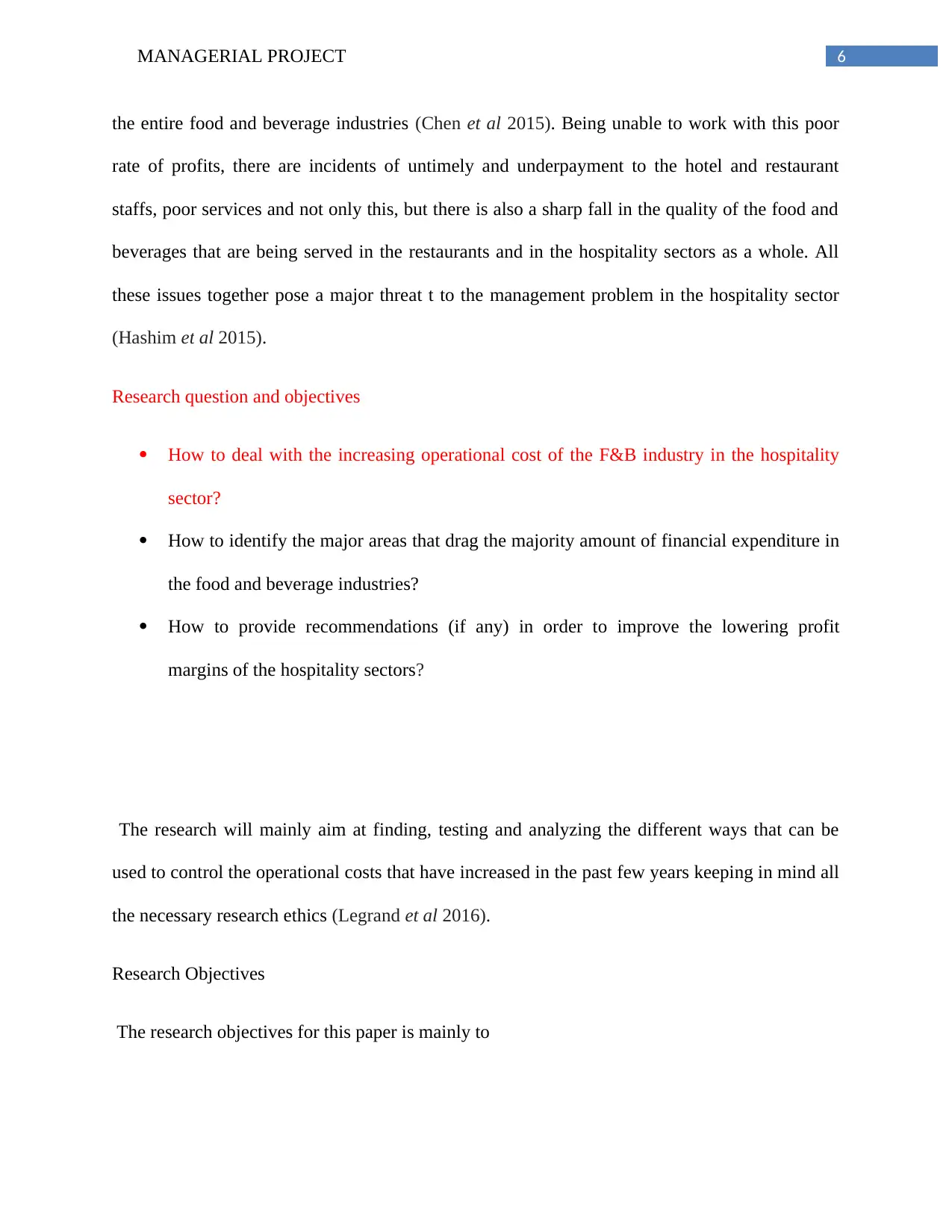
6MANAGERIAL PROJECT
the entire food and beverage industries (Chen et al 2015). Being unable to work with this poor
rate of profits, there are incidents of untimely and underpayment to the hotel and restaurant
staffs, poor services and not only this, but there is also a sharp fall in the quality of the food and
beverages that are being served in the restaurants and in the hospitality sectors as a whole. All
these issues together pose a major threat t to the management problem in the hospitality sector
(Hashim et al 2015).
Research question and objectives
How to deal with the increasing operational cost of the F&B industry in the hospitality
sector?
How to identify the major areas that drag the majority amount of financial expenditure in
the food and beverage industries?
How to provide recommendations (if any) in order to improve the lowering profit
margins of the hospitality sectors?
The research will mainly aim at finding, testing and analyzing the different ways that can be
used to control the operational costs that have increased in the past few years keeping in mind all
the necessary research ethics (Legrand et al 2016).
Research Objectives
The research objectives for this paper is mainly to
the entire food and beverage industries (Chen et al 2015). Being unable to work with this poor
rate of profits, there are incidents of untimely and underpayment to the hotel and restaurant
staffs, poor services and not only this, but there is also a sharp fall in the quality of the food and
beverages that are being served in the restaurants and in the hospitality sectors as a whole. All
these issues together pose a major threat t to the management problem in the hospitality sector
(Hashim et al 2015).
Research question and objectives
How to deal with the increasing operational cost of the F&B industry in the hospitality
sector?
How to identify the major areas that drag the majority amount of financial expenditure in
the food and beverage industries?
How to provide recommendations (if any) in order to improve the lowering profit
margins of the hospitality sectors?
The research will mainly aim at finding, testing and analyzing the different ways that can be
used to control the operational costs that have increased in the past few years keeping in mind all
the necessary research ethics (Legrand et al 2016).
Research Objectives
The research objectives for this paper is mainly to
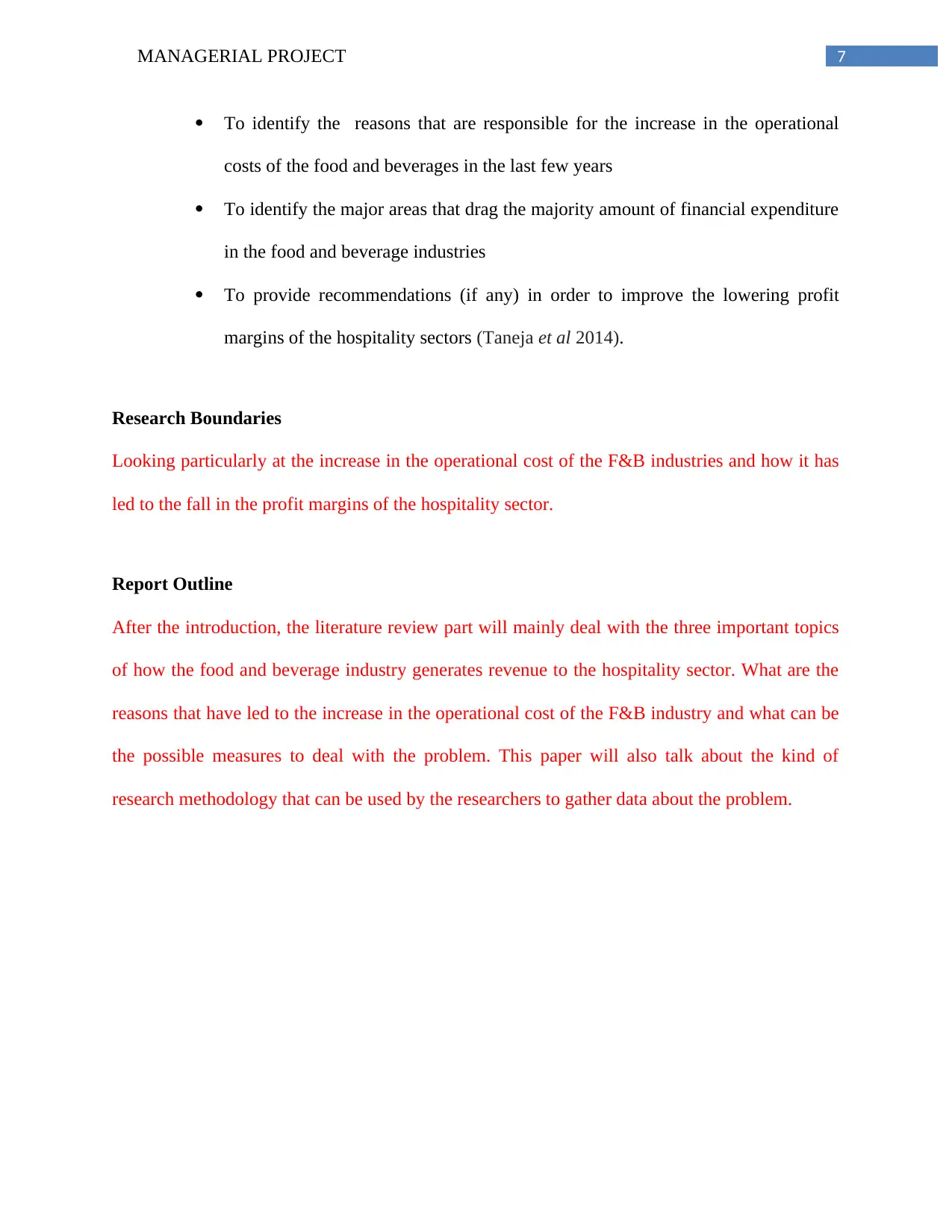
7MANAGERIAL PROJECT
To identify the reasons that are responsible for the increase in the operational
costs of the food and beverages in the last few years
To identify the major areas that drag the majority amount of financial expenditure
in the food and beverage industries
To provide recommendations (if any) in order to improve the lowering profit
margins of the hospitality sectors (Taneja et al 2014).
Research Boundaries
Looking particularly at the increase in the operational cost of the F&B industries and how it has
led to the fall in the profit margins of the hospitality sector.
Report Outline
After the introduction, the literature review part will mainly deal with the three important topics
of how the food and beverage industry generates revenue to the hospitality sector. What are the
reasons that have led to the increase in the operational cost of the F&B industry and what can be
the possible measures to deal with the problem. This paper will also talk about the kind of
research methodology that can be used by the researchers to gather data about the problem.
To identify the reasons that are responsible for the increase in the operational
costs of the food and beverages in the last few years
To identify the major areas that drag the majority amount of financial expenditure
in the food and beverage industries
To provide recommendations (if any) in order to improve the lowering profit
margins of the hospitality sectors (Taneja et al 2014).
Research Boundaries
Looking particularly at the increase in the operational cost of the F&B industries and how it has
led to the fall in the profit margins of the hospitality sector.
Report Outline
After the introduction, the literature review part will mainly deal with the three important topics
of how the food and beverage industry generates revenue to the hospitality sector. What are the
reasons that have led to the increase in the operational cost of the F&B industry and what can be
the possible measures to deal with the problem. This paper will also talk about the kind of
research methodology that can be used by the researchers to gather data about the problem.
Secure Best Marks with AI Grader
Need help grading? Try our AI Grader for instant feedback on your assignments.
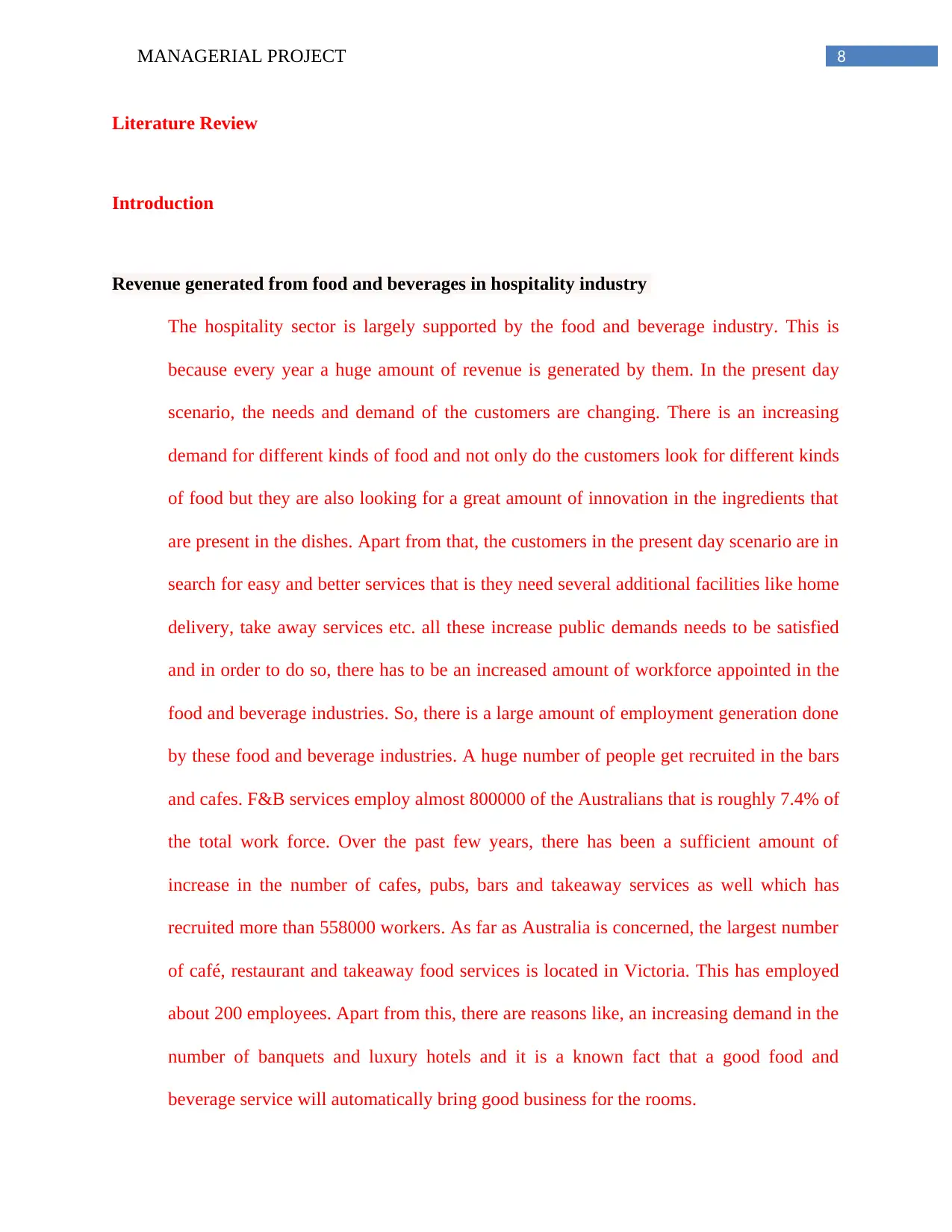
8MANAGERIAL PROJECT
Literature Review
Introduction
Revenue generated from food and beverages in hospitality industry
The hospitality sector is largely supported by the food and beverage industry. This is
because every year a huge amount of revenue is generated by them. In the present day
scenario, the needs and demand of the customers are changing. There is an increasing
demand for different kinds of food and not only do the customers look for different kinds
of food but they are also looking for a great amount of innovation in the ingredients that
are present in the dishes. Apart from that, the customers in the present day scenario are in
search for easy and better services that is they need several additional facilities like home
delivery, take away services etc. all these increase public demands needs to be satisfied
and in order to do so, there has to be an increased amount of workforce appointed in the
food and beverage industries. So, there is a large amount of employment generation done
by these food and beverage industries. A huge number of people get recruited in the bars
and cafes. F&B services employ almost 800000 of the Australians that is roughly 7.4% of
the total work force. Over the past few years, there has been a sufficient amount of
increase in the number of cafes, pubs, bars and takeaway services as well which has
recruited more than 558000 workers. As far as Australia is concerned, the largest number
of café, restaurant and takeaway food services is located in Victoria. This has employed
about 200 employees. Apart from this, there are reasons like, an increasing demand in the
number of banquets and luxury hotels and it is a known fact that a good food and
beverage service will automatically bring good business for the rooms.
Literature Review
Introduction
Revenue generated from food and beverages in hospitality industry
The hospitality sector is largely supported by the food and beverage industry. This is
because every year a huge amount of revenue is generated by them. In the present day
scenario, the needs and demand of the customers are changing. There is an increasing
demand for different kinds of food and not only do the customers look for different kinds
of food but they are also looking for a great amount of innovation in the ingredients that
are present in the dishes. Apart from that, the customers in the present day scenario are in
search for easy and better services that is they need several additional facilities like home
delivery, take away services etc. all these increase public demands needs to be satisfied
and in order to do so, there has to be an increased amount of workforce appointed in the
food and beverage industries. So, there is a large amount of employment generation done
by these food and beverage industries. A huge number of people get recruited in the bars
and cafes. F&B services employ almost 800000 of the Australians that is roughly 7.4% of
the total work force. Over the past few years, there has been a sufficient amount of
increase in the number of cafes, pubs, bars and takeaway services as well which has
recruited more than 558000 workers. As far as Australia is concerned, the largest number
of café, restaurant and takeaway food services is located in Victoria. This has employed
about 200 employees. Apart from this, there are reasons like, an increasing demand in the
number of banquets and luxury hotels and it is a known fact that a good food and
beverage service will automatically bring good business for the rooms.
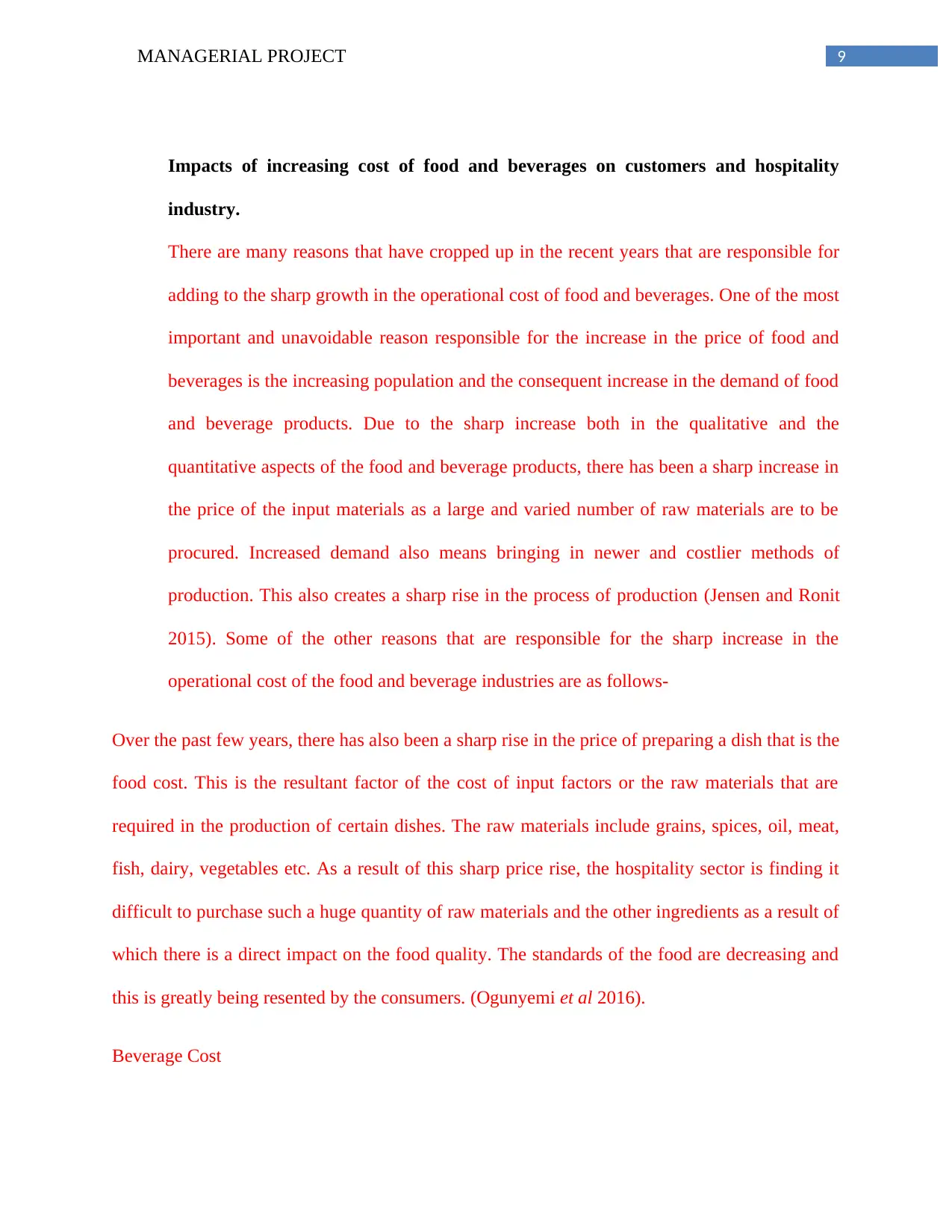
9MANAGERIAL PROJECT
Impacts of increasing cost of food and beverages on customers and hospitality
industry.
There are many reasons that have cropped up in the recent years that are responsible for
adding to the sharp growth in the operational cost of food and beverages. One of the most
important and unavoidable reason responsible for the increase in the price of food and
beverages is the increasing population and the consequent increase in the demand of food
and beverage products. Due to the sharp increase both in the qualitative and the
quantitative aspects of the food and beverage products, there has been a sharp increase in
the price of the input materials as a large and varied number of raw materials are to be
procured. Increased demand also means bringing in newer and costlier methods of
production. This also creates a sharp rise in the process of production (Jensen and Ronit
2015). Some of the other reasons that are responsible for the sharp increase in the
operational cost of the food and beverage industries are as follows-
Over the past few years, there has also been a sharp rise in the price of preparing a dish that is the
food cost. This is the resultant factor of the cost of input factors or the raw materials that are
required in the production of certain dishes. The raw materials include grains, spices, oil, meat,
fish, dairy, vegetables etc. As a result of this sharp price rise, the hospitality sector is finding it
difficult to purchase such a huge quantity of raw materials and the other ingredients as a result of
which there is a direct impact on the food quality. The standards of the food are decreasing and
this is greatly being resented by the consumers. (Ogunyemi et al 2016).
Beverage Cost
Impacts of increasing cost of food and beverages on customers and hospitality
industry.
There are many reasons that have cropped up in the recent years that are responsible for
adding to the sharp growth in the operational cost of food and beverages. One of the most
important and unavoidable reason responsible for the increase in the price of food and
beverages is the increasing population and the consequent increase in the demand of food
and beverage products. Due to the sharp increase both in the qualitative and the
quantitative aspects of the food and beverage products, there has been a sharp increase in
the price of the input materials as a large and varied number of raw materials are to be
procured. Increased demand also means bringing in newer and costlier methods of
production. This also creates a sharp rise in the process of production (Jensen and Ronit
2015). Some of the other reasons that are responsible for the sharp increase in the
operational cost of the food and beverage industries are as follows-
Over the past few years, there has also been a sharp rise in the price of preparing a dish that is the
food cost. This is the resultant factor of the cost of input factors or the raw materials that are
required in the production of certain dishes. The raw materials include grains, spices, oil, meat,
fish, dairy, vegetables etc. As a result of this sharp price rise, the hospitality sector is finding it
difficult to purchase such a huge quantity of raw materials and the other ingredients as a result of
which there is a direct impact on the food quality. The standards of the food are decreasing and
this is greatly being resented by the consumers. (Ogunyemi et al 2016).
Beverage Cost

10MANAGERIAL PROJECT
Beverage cost refers to the cost of the beverages served in the bars and the restaurants like
alcohols, mock tails, cocktails, juices, tea, coffee and several other such related products.Labor
Cost is a major area that draws a good amount of money thus increasing the operational costs of
the food and beverages in the hospitality sectors. Labor staffs are needed everywhere, at each
and every level of the food and beverage industries. They form the very indispensible part of the
food and beverage industries. Be a restaurant, a bar, a club or any other food outlets, labor is
needed everywhere. They are needed for the running and managing of the entire restaurant or
any other food outlets (Stocks 2013). A good amount of money is also incurred in the payments
that have to be made to these restaurant staffs (Grekova et al 2014). But owing to the sharp
increase in the operational cost of the food and beverage industries, the hospitality sector has to
appoint a huge number of employees and a huge amount of money is needed for paying all the
stuffs and this is making it difficult for the hospitality sector to bear such huge expenses.
Changed standards of living of people
As the population, the demand and the standards of living of people are increasing, there is
naturally an increase in the expectations of people as well. In order to standout to this
expectation standards of the customers, a separate and huge amount of money is also incurred on
additional aspects like store outlets, additional benefits like free internet access etc., and as it is a
known fact that customer satisfaction is the key to success for today’s industries. The hospitality
sector is no exception (Ogunyemi et al 2016). But in the present day scenario, the hospitality
sector is finding it very difficult to cope up with all these expenditures, and hence, more and
more customers are having a huge distaste on the hospitality industries. Not only this, the hotels
are also finding it difficult to maintain a good food and beverage room service which is reducing
their goodwill, thus lowering their profit margins (Taneja et al 2014).
Beverage cost refers to the cost of the beverages served in the bars and the restaurants like
alcohols, mock tails, cocktails, juices, tea, coffee and several other such related products.Labor
Cost is a major area that draws a good amount of money thus increasing the operational costs of
the food and beverages in the hospitality sectors. Labor staffs are needed everywhere, at each
and every level of the food and beverage industries. They form the very indispensible part of the
food and beverage industries. Be a restaurant, a bar, a club or any other food outlets, labor is
needed everywhere. They are needed for the running and managing of the entire restaurant or
any other food outlets (Stocks 2013). A good amount of money is also incurred in the payments
that have to be made to these restaurant staffs (Grekova et al 2014). But owing to the sharp
increase in the operational cost of the food and beverage industries, the hospitality sector has to
appoint a huge number of employees and a huge amount of money is needed for paying all the
stuffs and this is making it difficult for the hospitality sector to bear such huge expenses.
Changed standards of living of people
As the population, the demand and the standards of living of people are increasing, there is
naturally an increase in the expectations of people as well. In order to standout to this
expectation standards of the customers, a separate and huge amount of money is also incurred on
additional aspects like store outlets, additional benefits like free internet access etc., and as it is a
known fact that customer satisfaction is the key to success for today’s industries. The hospitality
sector is no exception (Ogunyemi et al 2016). But in the present day scenario, the hospitality
sector is finding it very difficult to cope up with all these expenditures, and hence, more and
more customers are having a huge distaste on the hospitality industries. Not only this, the hotels
are also finding it difficult to maintain a good food and beverage room service which is reducing
their goodwill, thus lowering their profit margins (Taneja et al 2014).
Paraphrase This Document
Need a fresh take? Get an instant paraphrase of this document with our AI Paraphraser
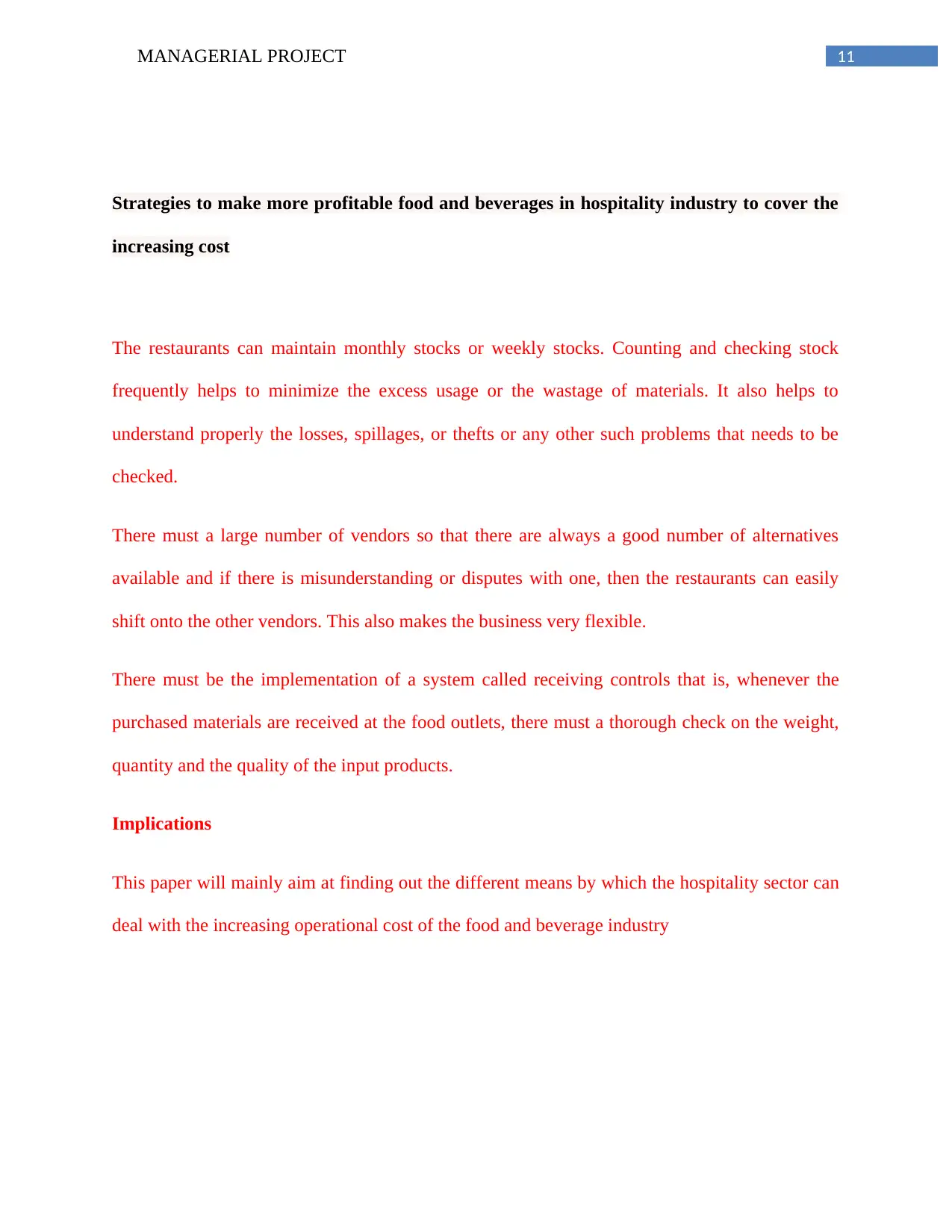
11MANAGERIAL PROJECT
Strategies to make more profitable food and beverages in hospitality industry to cover the
increasing cost
The restaurants can maintain monthly stocks or weekly stocks. Counting and checking stock
frequently helps to minimize the excess usage or the wastage of materials. It also helps to
understand properly the losses, spillages, or thefts or any other such problems that needs to be
checked.
There must a large number of vendors so that there are always a good number of alternatives
available and if there is misunderstanding or disputes with one, then the restaurants can easily
shift onto the other vendors. This also makes the business very flexible.
There must be the implementation of a system called receiving controls that is, whenever the
purchased materials are received at the food outlets, there must a thorough check on the weight,
quantity and the quality of the input products.
Implications
This paper will mainly aim at finding out the different means by which the hospitality sector can
deal with the increasing operational cost of the food and beverage industry
Strategies to make more profitable food and beverages in hospitality industry to cover the
increasing cost
The restaurants can maintain monthly stocks or weekly stocks. Counting and checking stock
frequently helps to minimize the excess usage or the wastage of materials. It also helps to
understand properly the losses, spillages, or thefts or any other such problems that needs to be
checked.
There must a large number of vendors so that there are always a good number of alternatives
available and if there is misunderstanding or disputes with one, then the restaurants can easily
shift onto the other vendors. This also makes the business very flexible.
There must be the implementation of a system called receiving controls that is, whenever the
purchased materials are received at the food outlets, there must a thorough check on the weight,
quantity and the quality of the input products.
Implications
This paper will mainly aim at finding out the different means by which the hospitality sector can
deal with the increasing operational cost of the food and beverage industry
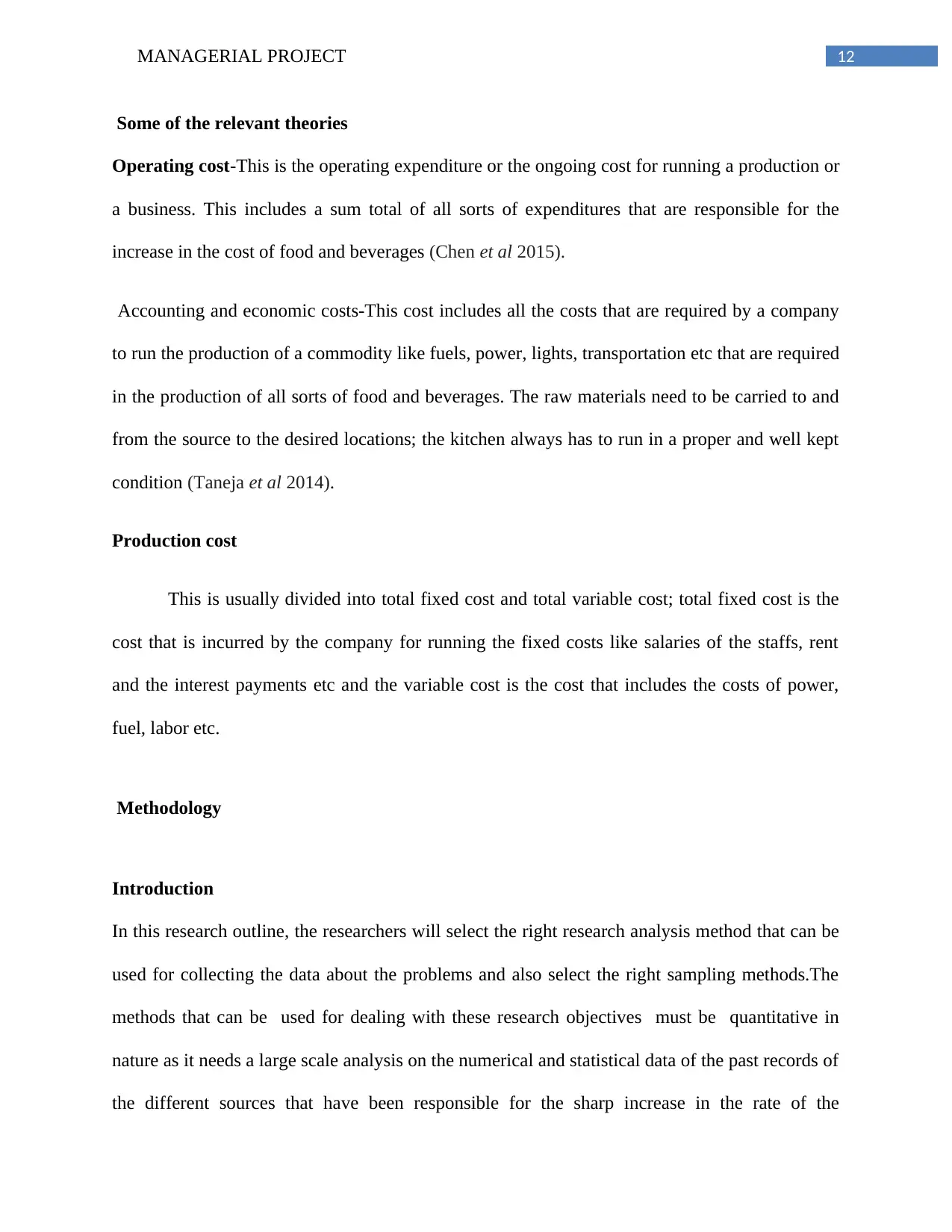
12MANAGERIAL PROJECT
Some of the relevant theories
Operating cost-This is the operating expenditure or the ongoing cost for running a production or
a business. This includes a sum total of all sorts of expenditures that are responsible for the
increase in the cost of food and beverages (Chen et al 2015).
Accounting and economic costs-This cost includes all the costs that are required by a company
to run the production of a commodity like fuels, power, lights, transportation etc that are required
in the production of all sorts of food and beverages. The raw materials need to be carried to and
from the source to the desired locations; the kitchen always has to run in a proper and well kept
condition (Taneja et al 2014).
Production cost
This is usually divided into total fixed cost and total variable cost; total fixed cost is the
cost that is incurred by the company for running the fixed costs like salaries of the staffs, rent
and the interest payments etc and the variable cost is the cost that includes the costs of power,
fuel, labor etc.
Methodology
Introduction
In this research outline, the researchers will select the right research analysis method that can be
used for collecting the data about the problems and also select the right sampling methods.The
methods that can be used for dealing with these research objectives must be quantitative in
nature as it needs a large scale analysis on the numerical and statistical data of the past records of
the different sources that have been responsible for the sharp increase in the rate of the
Some of the relevant theories
Operating cost-This is the operating expenditure or the ongoing cost for running a production or
a business. This includes a sum total of all sorts of expenditures that are responsible for the
increase in the cost of food and beverages (Chen et al 2015).
Accounting and economic costs-This cost includes all the costs that are required by a company
to run the production of a commodity like fuels, power, lights, transportation etc that are required
in the production of all sorts of food and beverages. The raw materials need to be carried to and
from the source to the desired locations; the kitchen always has to run in a proper and well kept
condition (Taneja et al 2014).
Production cost
This is usually divided into total fixed cost and total variable cost; total fixed cost is the
cost that is incurred by the company for running the fixed costs like salaries of the staffs, rent
and the interest payments etc and the variable cost is the cost that includes the costs of power,
fuel, labor etc.
Methodology
Introduction
In this research outline, the researchers will select the right research analysis method that can be
used for collecting the data about the problems and also select the right sampling methods.The
methods that can be used for dealing with these research objectives must be quantitative in
nature as it needs a large scale analysis on the numerical and statistical data of the past records of
the different sources that have been responsible for the sharp increase in the rate of the
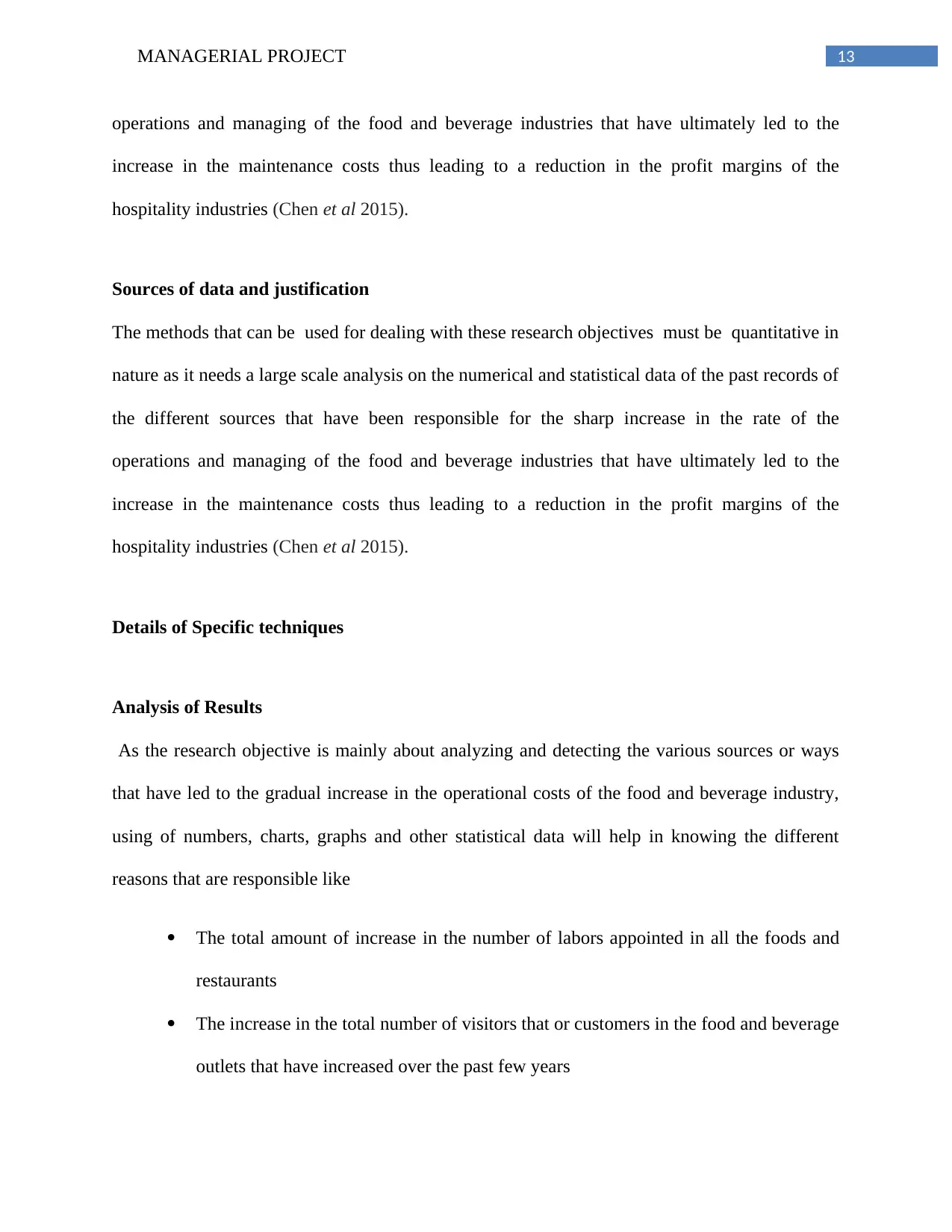
13MANAGERIAL PROJECT
operations and managing of the food and beverage industries that have ultimately led to the
increase in the maintenance costs thus leading to a reduction in the profit margins of the
hospitality industries (Chen et al 2015).
Sources of data and justification
The methods that can be used for dealing with these research objectives must be quantitative in
nature as it needs a large scale analysis on the numerical and statistical data of the past records of
the different sources that have been responsible for the sharp increase in the rate of the
operations and managing of the food and beverage industries that have ultimately led to the
increase in the maintenance costs thus leading to a reduction in the profit margins of the
hospitality industries (Chen et al 2015).
Details of Specific techniques
Analysis of Results
As the research objective is mainly about analyzing and detecting the various sources or ways
that have led to the gradual increase in the operational costs of the food and beverage industry,
using of numbers, charts, graphs and other statistical data will help in knowing the different
reasons that are responsible like
The total amount of increase in the number of labors appointed in all the foods and
restaurants
The increase in the total number of visitors that or customers in the food and beverage
outlets that have increased over the past few years
operations and managing of the food and beverage industries that have ultimately led to the
increase in the maintenance costs thus leading to a reduction in the profit margins of the
hospitality industries (Chen et al 2015).
Sources of data and justification
The methods that can be used for dealing with these research objectives must be quantitative in
nature as it needs a large scale analysis on the numerical and statistical data of the past records of
the different sources that have been responsible for the sharp increase in the rate of the
operations and managing of the food and beverage industries that have ultimately led to the
increase in the maintenance costs thus leading to a reduction in the profit margins of the
hospitality industries (Chen et al 2015).
Details of Specific techniques
Analysis of Results
As the research objective is mainly about analyzing and detecting the various sources or ways
that have led to the gradual increase in the operational costs of the food and beverage industry,
using of numbers, charts, graphs and other statistical data will help in knowing the different
reasons that are responsible like
The total amount of increase in the number of labors appointed in all the foods and
restaurants
The increase in the total number of visitors that or customers in the food and beverage
outlets that have increased over the past few years
Secure Best Marks with AI Grader
Need help grading? Try our AI Grader for instant feedback on your assignments.
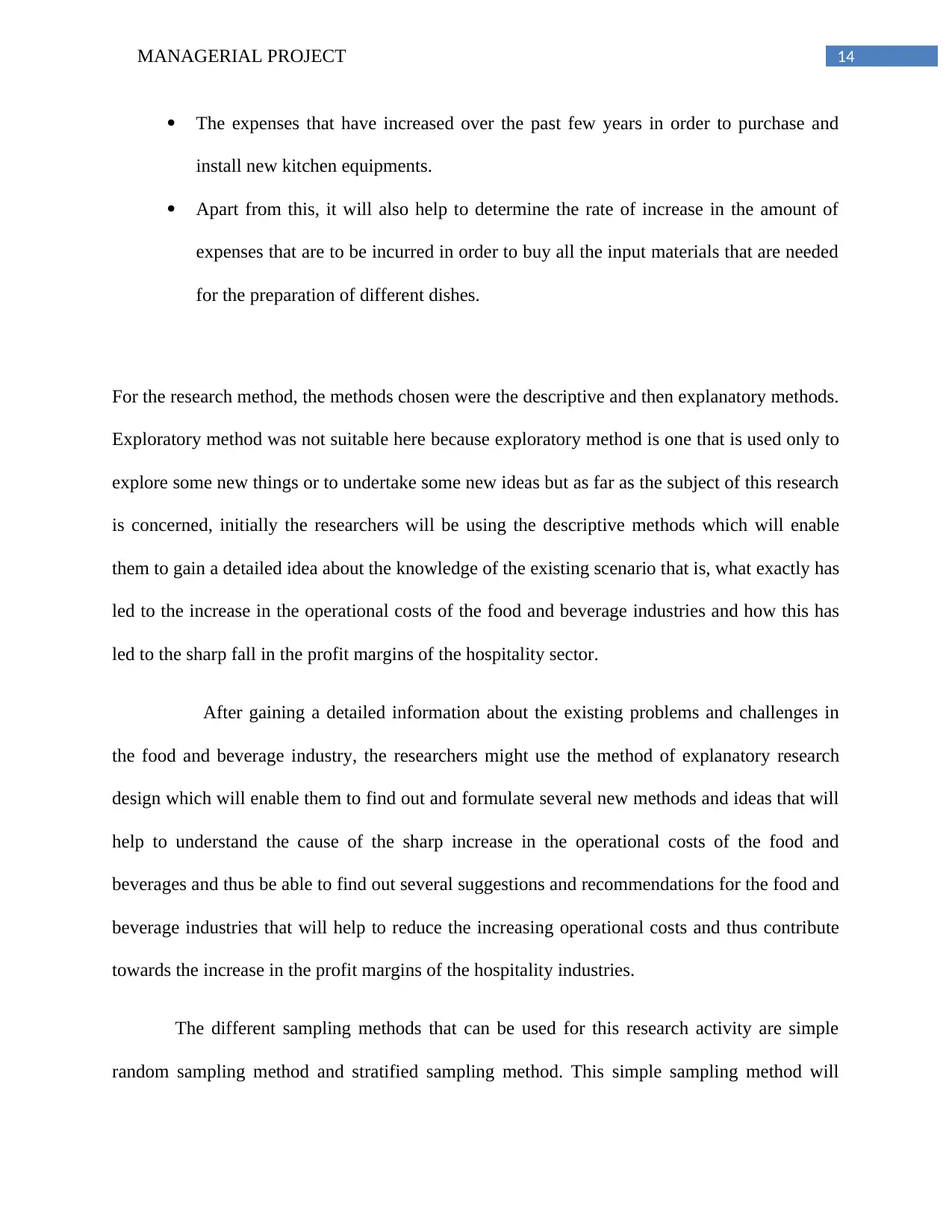
14MANAGERIAL PROJECT
The expenses that have increased over the past few years in order to purchase and
install new kitchen equipments.
Apart from this, it will also help to determine the rate of increase in the amount of
expenses that are to be incurred in order to buy all the input materials that are needed
for the preparation of different dishes.
For the research method, the methods chosen were the descriptive and then explanatory methods.
Exploratory method was not suitable here because exploratory method is one that is used only to
explore some new things or to undertake some new ideas but as far as the subject of this research
is concerned, initially the researchers will be using the descriptive methods which will enable
them to gain a detailed idea about the knowledge of the existing scenario that is, what exactly has
led to the increase in the operational costs of the food and beverage industries and how this has
led to the sharp fall in the profit margins of the hospitality sector.
After gaining a detailed information about the existing problems and challenges in
the food and beverage industry, the researchers might use the method of explanatory research
design which will enable them to find out and formulate several new methods and ideas that will
help to understand the cause of the sharp increase in the operational costs of the food and
beverages and thus be able to find out several suggestions and recommendations for the food and
beverage industries that will help to reduce the increasing operational costs and thus contribute
towards the increase in the profit margins of the hospitality industries.
The different sampling methods that can be used for this research activity are simple
random sampling method and stratified sampling method. This simple sampling method will
The expenses that have increased over the past few years in order to purchase and
install new kitchen equipments.
Apart from this, it will also help to determine the rate of increase in the amount of
expenses that are to be incurred in order to buy all the input materials that are needed
for the preparation of different dishes.
For the research method, the methods chosen were the descriptive and then explanatory methods.
Exploratory method was not suitable here because exploratory method is one that is used only to
explore some new things or to undertake some new ideas but as far as the subject of this research
is concerned, initially the researchers will be using the descriptive methods which will enable
them to gain a detailed idea about the knowledge of the existing scenario that is, what exactly has
led to the increase in the operational costs of the food and beverage industries and how this has
led to the sharp fall in the profit margins of the hospitality sector.
After gaining a detailed information about the existing problems and challenges in
the food and beverage industry, the researchers might use the method of explanatory research
design which will enable them to find out and formulate several new methods and ideas that will
help to understand the cause of the sharp increase in the operational costs of the food and
beverages and thus be able to find out several suggestions and recommendations for the food and
beverage industries that will help to reduce the increasing operational costs and thus contribute
towards the increase in the profit margins of the hospitality industries.
The different sampling methods that can be used for this research activity are simple
random sampling method and stratified sampling method. This simple sampling method will
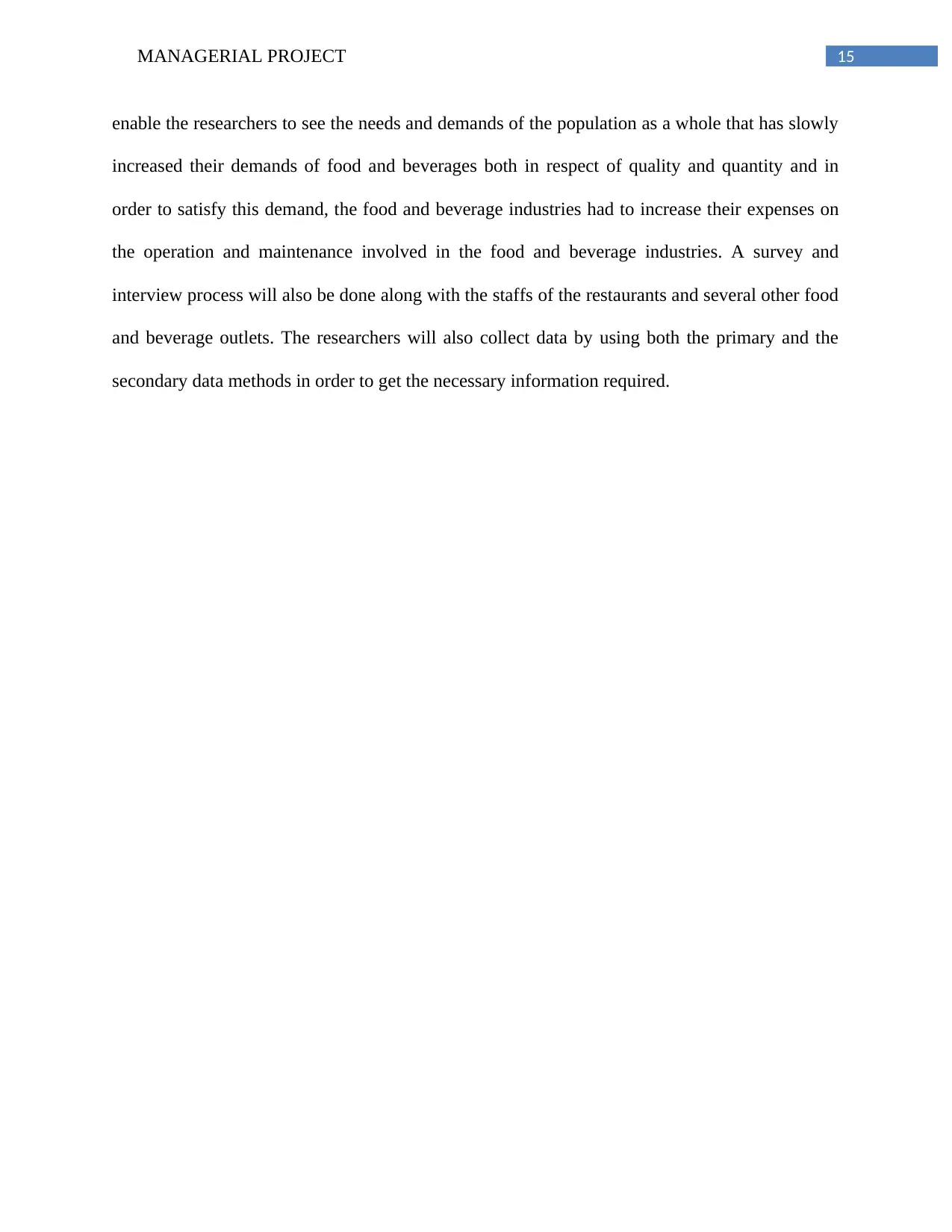
15MANAGERIAL PROJECT
enable the researchers to see the needs and demands of the population as a whole that has slowly
increased their demands of food and beverages both in respect of quality and quantity and in
order to satisfy this demand, the food and beverage industries had to increase their expenses on
the operation and maintenance involved in the food and beverage industries. A survey and
interview process will also be done along with the staffs of the restaurants and several other food
and beverage outlets. The researchers will also collect data by using both the primary and the
secondary data methods in order to get the necessary information required.
enable the researchers to see the needs and demands of the population as a whole that has slowly
increased their demands of food and beverages both in respect of quality and quantity and in
order to satisfy this demand, the food and beverage industries had to increase their expenses on
the operation and maintenance involved in the food and beverage industries. A survey and
interview process will also be done along with the staffs of the restaurants and several other food
and beverage outlets. The researchers will also collect data by using both the primary and the
secondary data methods in order to get the necessary information required.
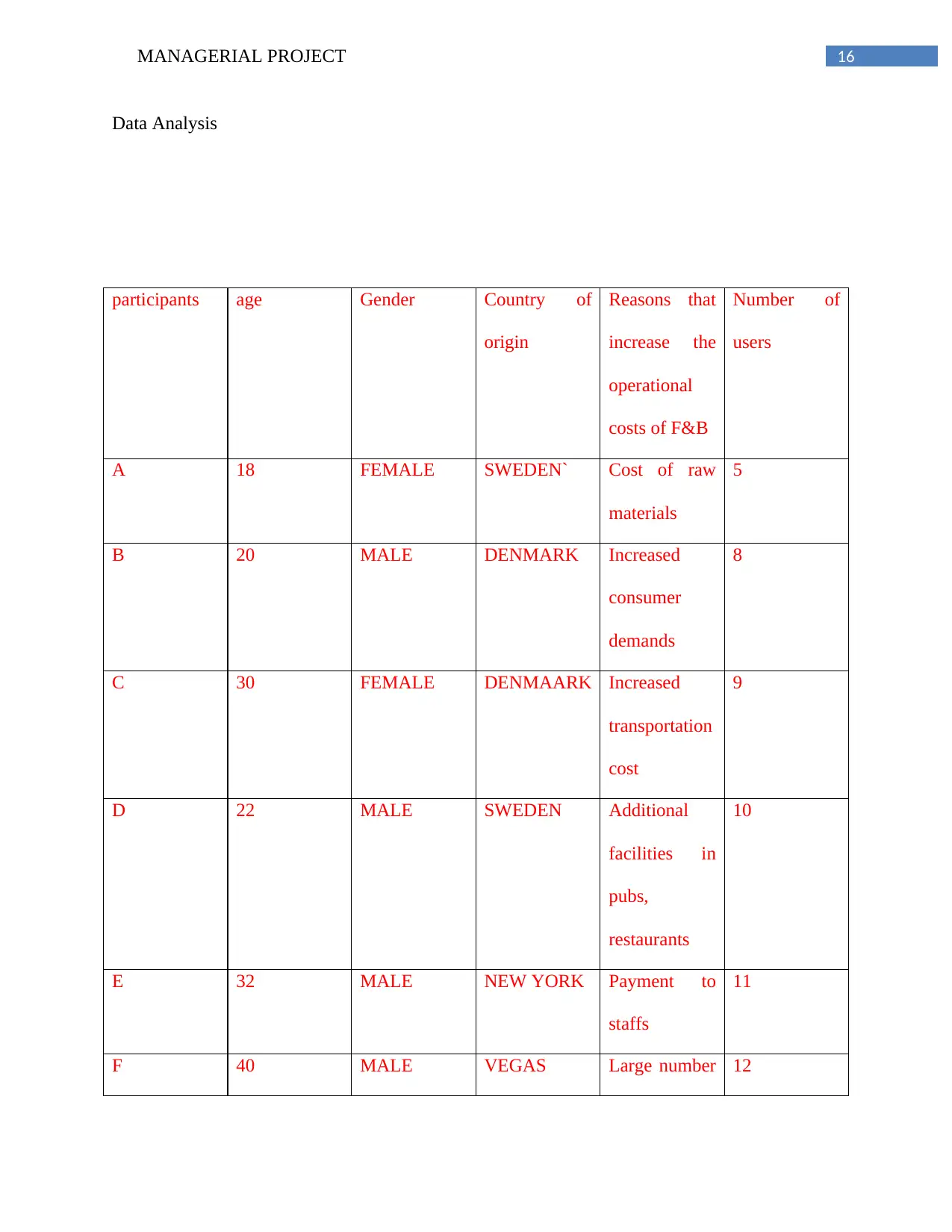
16MANAGERIAL PROJECT
Data Analysis
participants age Gender Country of
origin
Reasons that
increase the
operational
costs of F&B
Number of
users
A 18 FEMALE SWEDEN` Cost of raw
materials
5
B 20 MALE DENMARK Increased
consumer
demands
8
C 30 FEMALE DENMAARK Increased
transportation
cost
9
D 22 MALE SWEDEN Additional
facilities in
pubs,
restaurants
10
E 32 MALE NEW YORK Payment to
staffs
11
F 40 MALE VEGAS Large number 12
Data Analysis
participants age Gender Country of
origin
Reasons that
increase the
operational
costs of F&B
Number of
users
A 18 FEMALE SWEDEN` Cost of raw
materials
5
B 20 MALE DENMARK Increased
consumer
demands
8
C 30 FEMALE DENMAARK Increased
transportation
cost
9
D 22 MALE SWEDEN Additional
facilities in
pubs,
restaurants
10
E 32 MALE NEW YORK Payment to
staffs
11
F 40 MALE VEGAS Large number 12
Paraphrase This Document
Need a fresh take? Get an instant paraphrase of this document with our AI Paraphraser
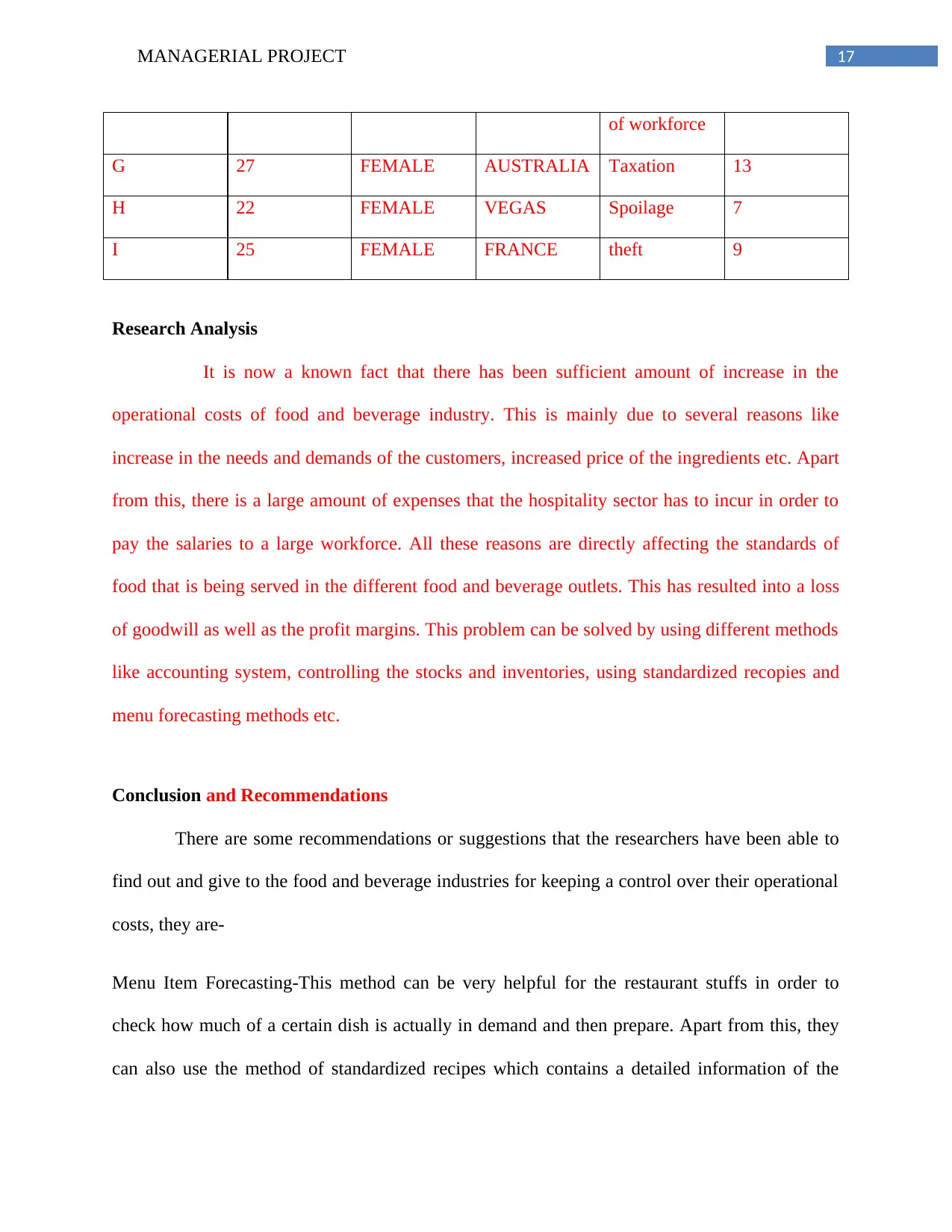
17MANAGERIAL PROJECT
of workforce
G 27 FEMALE AUSTRALIA Taxation 13
H 22 FEMALE VEGAS Spoilage 7
I 25 FEMALE FRANCE theft 9
Research Analysis
It is now a known fact that there has been sufficient amount of increase in the
operational costs of food and beverage industry. This is mainly due to several reasons like
increase in the needs and demands of the customers, increased price of the ingredients etc. Apart
from this, there is a large amount of expenses that the hospitality sector has to incur in order to
pay the salaries to a large workforce. All these reasons are directly affecting the standards of
food that is being served in the different food and beverage outlets. This has resulted into a loss
of goodwill as well as the profit margins. This problem can be solved by using different methods
like accounting system, controlling the stocks and inventories, using standardized recopies and
menu forecasting methods etc.
Conclusion and Recommendations
There are some recommendations or suggestions that the researchers have been able to
find out and give to the food and beverage industries for keeping a control over their operational
costs, they are-
Menu Item Forecasting-This method can be very helpful for the restaurant stuffs in order to
check how much of a certain dish is actually in demand and then prepare. Apart from this, they
can also use the method of standardized recipes which contains a detailed information of the
of workforce
G 27 FEMALE AUSTRALIA Taxation 13
H 22 FEMALE VEGAS Spoilage 7
I 25 FEMALE FRANCE theft 9
Research Analysis
It is now a known fact that there has been sufficient amount of increase in the
operational costs of food and beverage industry. This is mainly due to several reasons like
increase in the needs and demands of the customers, increased price of the ingredients etc. Apart
from this, there is a large amount of expenses that the hospitality sector has to incur in order to
pay the salaries to a large workforce. All these reasons are directly affecting the standards of
food that is being served in the different food and beverage outlets. This has resulted into a loss
of goodwill as well as the profit margins. This problem can be solved by using different methods
like accounting system, controlling the stocks and inventories, using standardized recopies and
menu forecasting methods etc.
Conclusion and Recommendations
There are some recommendations or suggestions that the researchers have been able to
find out and give to the food and beverage industries for keeping a control over their operational
costs, they are-
Menu Item Forecasting-This method can be very helpful for the restaurant stuffs in order to
check how much of a certain dish is actually in demand and then prepare. Apart from this, they
can also use the method of standardized recipes which contains a detailed information of the
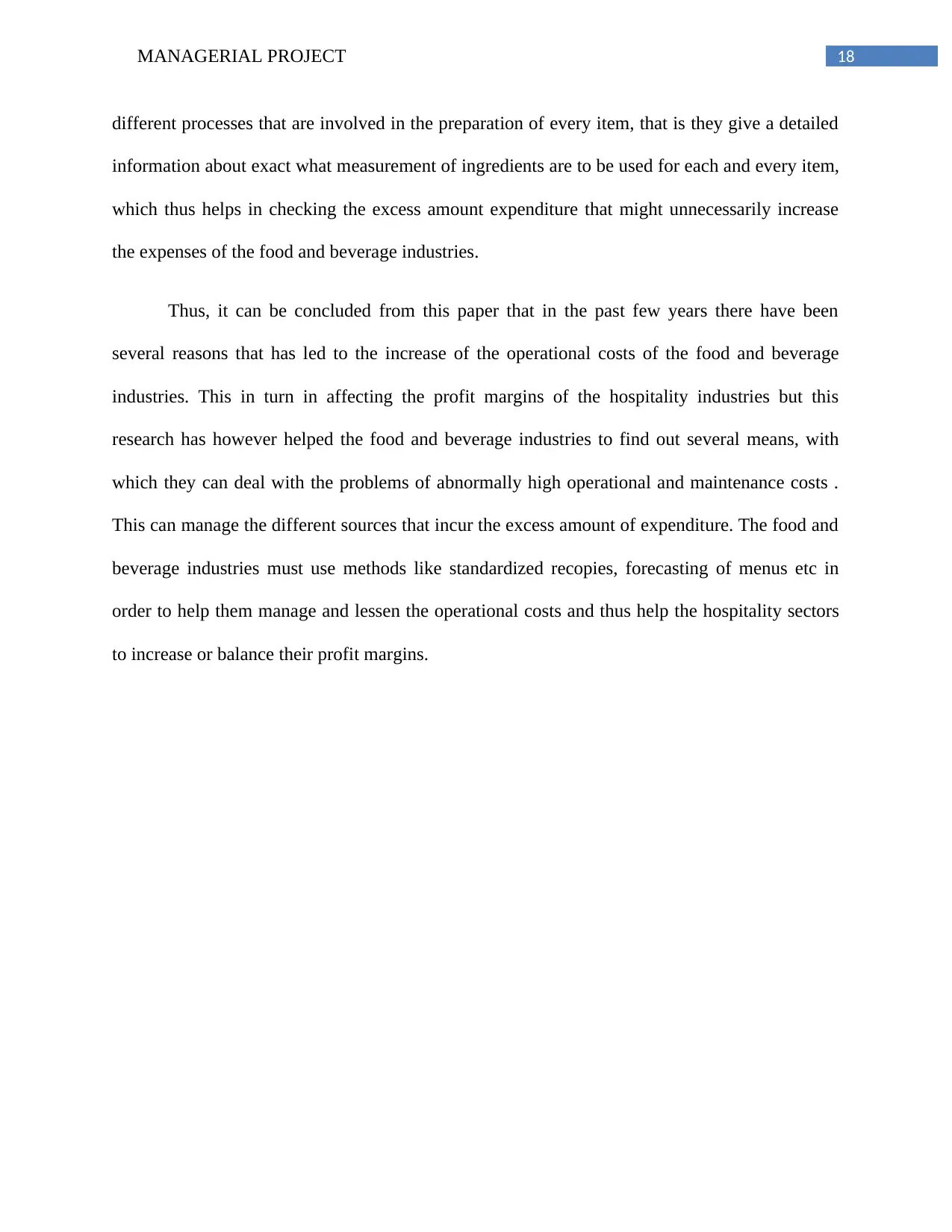
18MANAGERIAL PROJECT
different processes that are involved in the preparation of every item, that is they give a detailed
information about exact what measurement of ingredients are to be used for each and every item,
which thus helps in checking the excess amount expenditure that might unnecessarily increase
the expenses of the food and beverage industries.
Thus, it can be concluded from this paper that in the past few years there have been
several reasons that has led to the increase of the operational costs of the food and beverage
industries. This in turn in affecting the profit margins of the hospitality industries but this
research has however helped the food and beverage industries to find out several means, with
which they can deal with the problems of abnormally high operational and maintenance costs .
This can manage the different sources that incur the excess amount of expenditure. The food and
beverage industries must use methods like standardized recopies, forecasting of menus etc in
order to help them manage and lessen the operational costs and thus help the hospitality sectors
to increase or balance their profit margins.
different processes that are involved in the preparation of every item, that is they give a detailed
information about exact what measurement of ingredients are to be used for each and every item,
which thus helps in checking the excess amount expenditure that might unnecessarily increase
the expenses of the food and beverage industries.
Thus, it can be concluded from this paper that in the past few years there have been
several reasons that has led to the increase of the operational costs of the food and beverage
industries. This in turn in affecting the profit margins of the hospitality industries but this
research has however helped the food and beverage industries to find out several means, with
which they can deal with the problems of abnormally high operational and maintenance costs .
This can manage the different sources that incur the excess amount of expenditure. The food and
beverage industries must use methods like standardized recopies, forecasting of menus etc in
order to help them manage and lessen the operational costs and thus help the hospitality sectors
to increase or balance their profit margins.
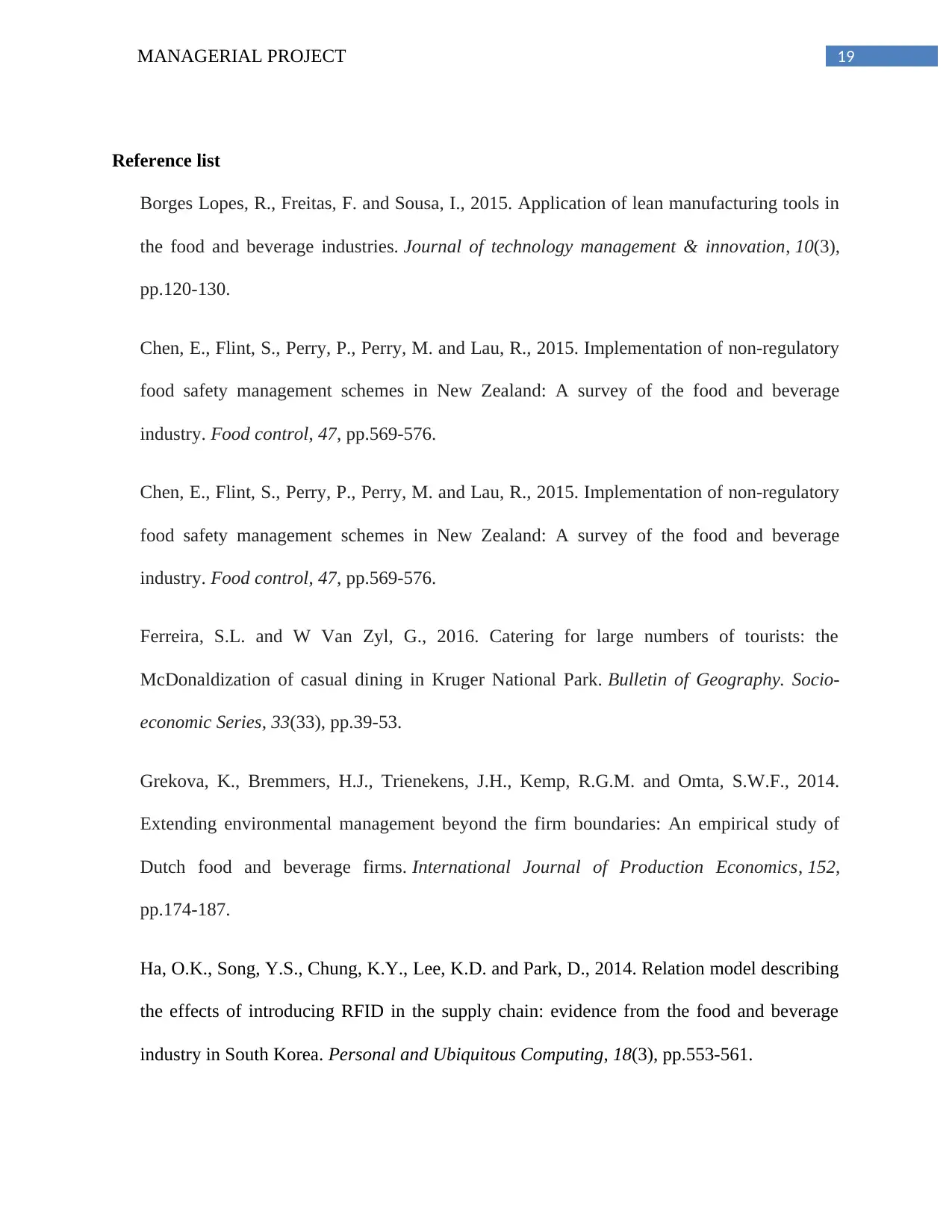
19MANAGERIAL PROJECT
Reference list
Borges Lopes, R., Freitas, F. and Sousa, I., 2015. Application of lean manufacturing tools in
the food and beverage industries. Journal of technology management & innovation, 10(3),
pp.120-130.
Chen, E., Flint, S., Perry, P., Perry, M. and Lau, R., 2015. Implementation of non-regulatory
food safety management schemes in New Zealand: A survey of the food and beverage
industry. Food control, 47, pp.569-576.
Chen, E., Flint, S., Perry, P., Perry, M. and Lau, R., 2015. Implementation of non-regulatory
food safety management schemes in New Zealand: A survey of the food and beverage
industry. Food control, 47, pp.569-576.
Ferreira, S.L. and W Van Zyl, G., 2016. Catering for large numbers of tourists: the
McDonaldization of casual dining in Kruger National Park. Bulletin of Geography. Socio-
economic Series, 33(33), pp.39-53.
Grekova, K., Bremmers, H.J., Trienekens, J.H., Kemp, R.G.M. and Omta, S.W.F., 2014.
Extending environmental management beyond the firm boundaries: An empirical study of
Dutch food and beverage firms. International Journal of Production Economics, 152,
pp.174-187.
Ha, O.K., Song, Y.S., Chung, K.Y., Lee, K.D. and Park, D., 2014. Relation model describing
the effects of introducing RFID in the supply chain: evidence from the food and beverage
industry in South Korea. Personal and Ubiquitous Computing, 18(3), pp.553-561.
Reference list
Borges Lopes, R., Freitas, F. and Sousa, I., 2015. Application of lean manufacturing tools in
the food and beverage industries. Journal of technology management & innovation, 10(3),
pp.120-130.
Chen, E., Flint, S., Perry, P., Perry, M. and Lau, R., 2015. Implementation of non-regulatory
food safety management schemes in New Zealand: A survey of the food and beverage
industry. Food control, 47, pp.569-576.
Chen, E., Flint, S., Perry, P., Perry, M. and Lau, R., 2015. Implementation of non-regulatory
food safety management schemes in New Zealand: A survey of the food and beverage
industry. Food control, 47, pp.569-576.
Ferreira, S.L. and W Van Zyl, G., 2016. Catering for large numbers of tourists: the
McDonaldization of casual dining in Kruger National Park. Bulletin of Geography. Socio-
economic Series, 33(33), pp.39-53.
Grekova, K., Bremmers, H.J., Trienekens, J.H., Kemp, R.G.M. and Omta, S.W.F., 2014.
Extending environmental management beyond the firm boundaries: An empirical study of
Dutch food and beverage firms. International Journal of Production Economics, 152,
pp.174-187.
Ha, O.K., Song, Y.S., Chung, K.Y., Lee, K.D. and Park, D., 2014. Relation model describing
the effects of introducing RFID in the supply chain: evidence from the food and beverage
industry in South Korea. Personal and Ubiquitous Computing, 18(3), pp.553-561.
Secure Best Marks with AI Grader
Need help grading? Try our AI Grader for instant feedback on your assignments.

20MANAGERIAL PROJECT
Hashim, P., Ridzwan, M., Bakar, J. and Mat Hashim, D., 2015. Collagen in food and
beverage industries. International Food Research Journal, 22(1).
Hegde, S., Win, S.S. and Trabold, T.A., 2017, June. Stabilizing the Anaerobic Digestion of
Food Waste for Biomethane Production. In ASME 2017 11th International Conference on
Energy Sustainability collocated with the ASME 2017 Power Conference Joint With ICOPE-
17, the ASME 2017 15th International Conference on Fuel Cell Science, Engineering and
Technology, and the ASME 2017 Nuclear Forum (pp. V001T02A002-V001T02A002).
American Society of Mechanical Engineers.
Jensen, J.D. and Ronit, K., 2015. Obesity, International Food and Beverage Industries, and
Self‐Regulation: The Fragmentation of Information Strategies. World Medical & Health
Policy, 7(3), pp.278-297.
Kumar, R., 2014. Corporate Social Responsibility-A study on hotel industry. Asian Journal
of Multidisciplinary Studies, 2(4).
Legrand, W., Sloan, P. and Chen, J.S., 2016. Sustainability in the hospitality industry:
Principles of sustainable operations. Routledge.
Lin, S.M., 2016. Understanding corporate social responsibility and brand equity: An
investigation of restaurant brand attributes and customer traits(Doctoral dissertation,
Oklahoma State University).
Nesheim, M.C., Oria, M., Yih, P.T., Resources, N. and National Research Council, 2015.
Social and Economic Effects of the US Food System.
Hashim, P., Ridzwan, M., Bakar, J. and Mat Hashim, D., 2015. Collagen in food and
beverage industries. International Food Research Journal, 22(1).
Hegde, S., Win, S.S. and Trabold, T.A., 2017, June. Stabilizing the Anaerobic Digestion of
Food Waste for Biomethane Production. In ASME 2017 11th International Conference on
Energy Sustainability collocated with the ASME 2017 Power Conference Joint With ICOPE-
17, the ASME 2017 15th International Conference on Fuel Cell Science, Engineering and
Technology, and the ASME 2017 Nuclear Forum (pp. V001T02A002-V001T02A002).
American Society of Mechanical Engineers.
Jensen, J.D. and Ronit, K., 2015. Obesity, International Food and Beverage Industries, and
Self‐Regulation: The Fragmentation of Information Strategies. World Medical & Health
Policy, 7(3), pp.278-297.
Kumar, R., 2014. Corporate Social Responsibility-A study on hotel industry. Asian Journal
of Multidisciplinary Studies, 2(4).
Legrand, W., Sloan, P. and Chen, J.S., 2016. Sustainability in the hospitality industry:
Principles of sustainable operations. Routledge.
Lin, S.M., 2016. Understanding corporate social responsibility and brand equity: An
investigation of restaurant brand attributes and customer traits(Doctoral dissertation,
Oklahoma State University).
Nesheim, M.C., Oria, M., Yih, P.T., Resources, N. and National Research Council, 2015.
Social and Economic Effects of the US Food System.
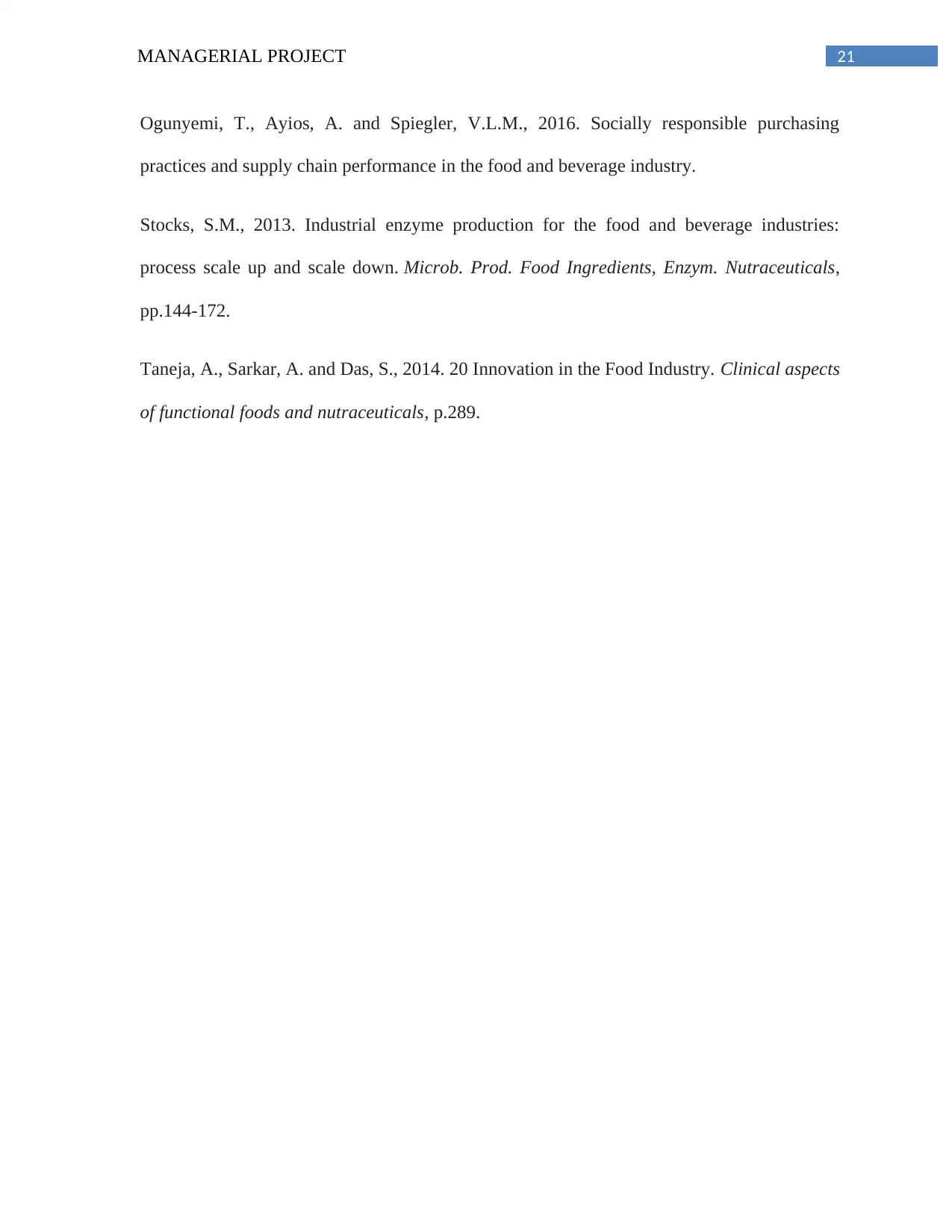
21MANAGERIAL PROJECT
Ogunyemi, T., Ayios, A. and Spiegler, V.L.M., 2016. Socially responsible purchasing
practices and supply chain performance in the food and beverage industry.
Stocks, S.M., 2013. Industrial enzyme production for the food and beverage industries:
process scale up and scale down. Microb. Prod. Food Ingredients, Enzym. Nutraceuticals,
pp.144-172.
Taneja, A., Sarkar, A. and Das, S., 2014. 20 Innovation in the Food Industry. Clinical aspects
of functional foods and nutraceuticals, p.289.
Ogunyemi, T., Ayios, A. and Spiegler, V.L.M., 2016. Socially responsible purchasing
practices and supply chain performance in the food and beverage industry.
Stocks, S.M., 2013. Industrial enzyme production for the food and beverage industries:
process scale up and scale down. Microb. Prod. Food Ingredients, Enzym. Nutraceuticals,
pp.144-172.
Taneja, A., Sarkar, A. and Das, S., 2014. 20 Innovation in the Food Industry. Clinical aspects
of functional foods and nutraceuticals, p.289.

22MANAGERIAL PROJECT
Appendix
There are ten survey questions that have been identified
1. Is high price of input product becoming one of the major reasons behind the increase
in the operational cost of F&B industries?
2. Will developing partnership with commercial organization solve the problem?
3. Will checking the spoilage of materials and wastage of materials help in solving the
problem?
4. Is the issue of payment of such a large number being staffs a major cause behind
increasing operational cost of F&B industry?
5. Will checking and revising their stocks on a daily or weekly basis be helpful for the
restaurants and cafes?
6. Will the method of menu forecasting be helpful in solving the problem?
7. Will the method of standardized recipe be helpful in solving the problem?
Appendix
There are ten survey questions that have been identified
1. Is high price of input product becoming one of the major reasons behind the increase
in the operational cost of F&B industries?
2. Will developing partnership with commercial organization solve the problem?
3. Will checking the spoilage of materials and wastage of materials help in solving the
problem?
4. Is the issue of payment of such a large number being staffs a major cause behind
increasing operational cost of F&B industry?
5. Will checking and revising their stocks on a daily or weekly basis be helpful for the
restaurants and cafes?
6. Will the method of menu forecasting be helpful in solving the problem?
7. Will the method of standardized recipe be helpful in solving the problem?
1 out of 22
Related Documents
Your All-in-One AI-Powered Toolkit for Academic Success.
+13062052269
info@desklib.com
Available 24*7 on WhatsApp / Email
![[object Object]](/_next/static/media/star-bottom.7253800d.svg)
Unlock your academic potential
© 2024 | Zucol Services PVT LTD | All rights reserved.





